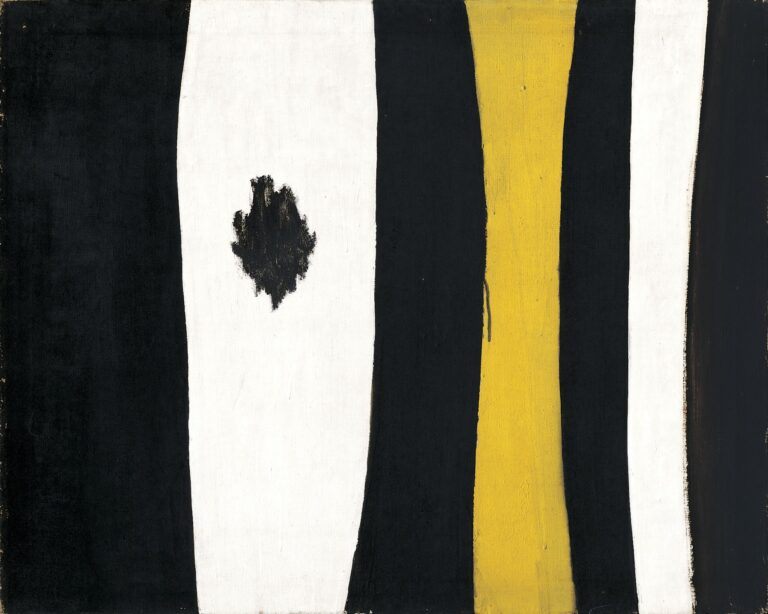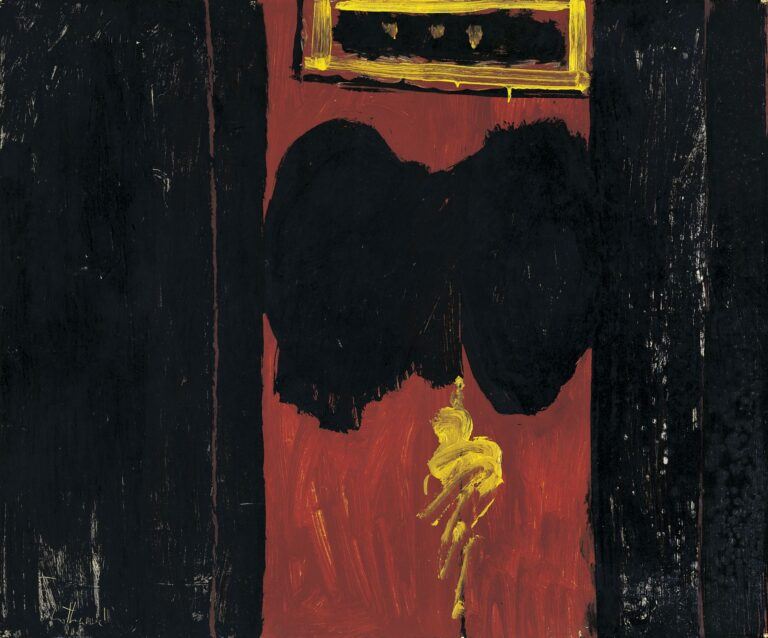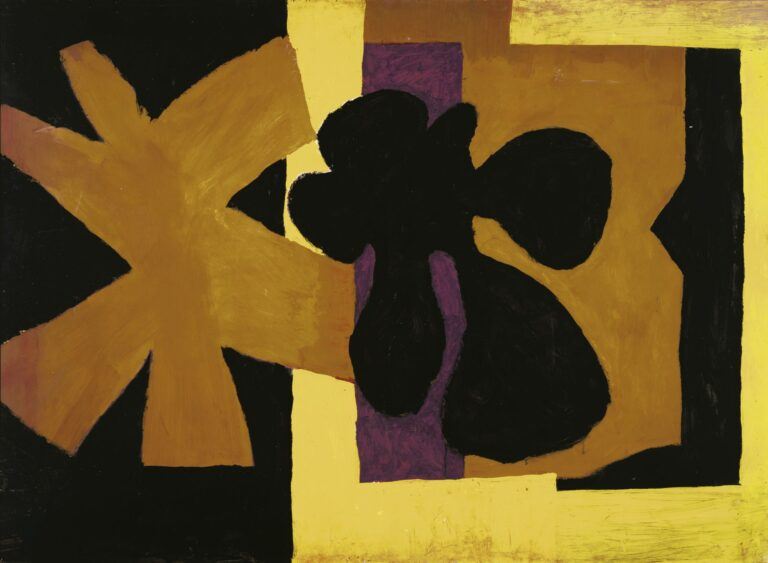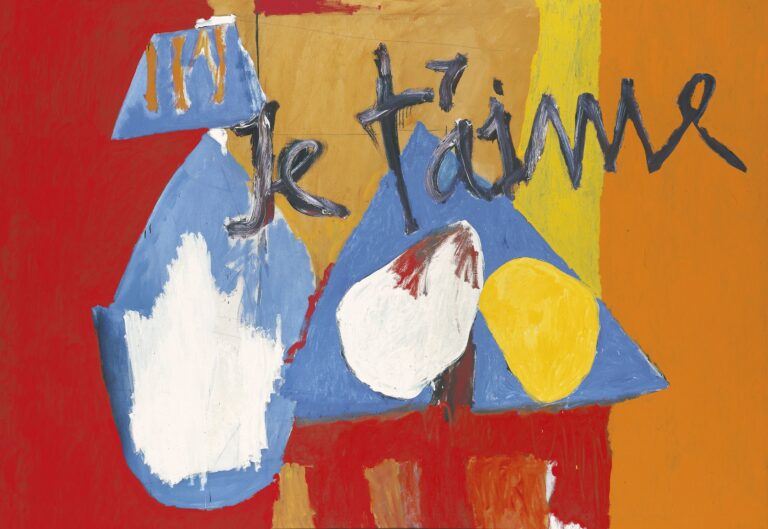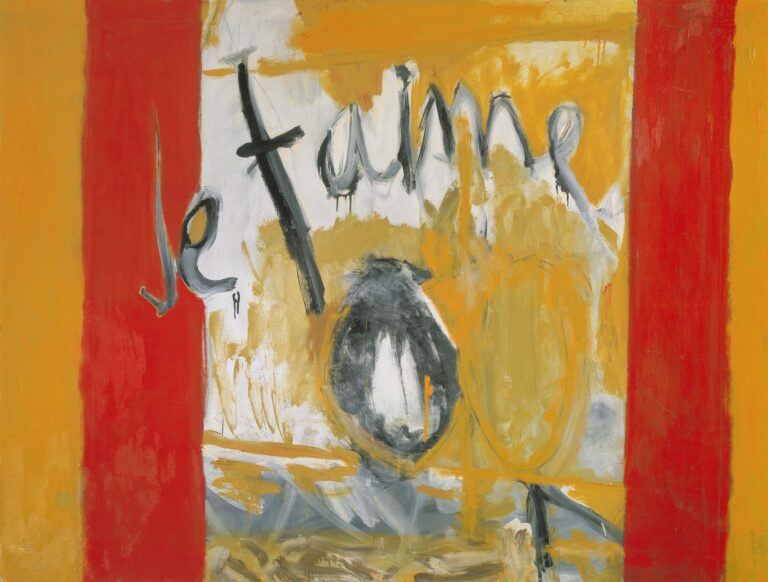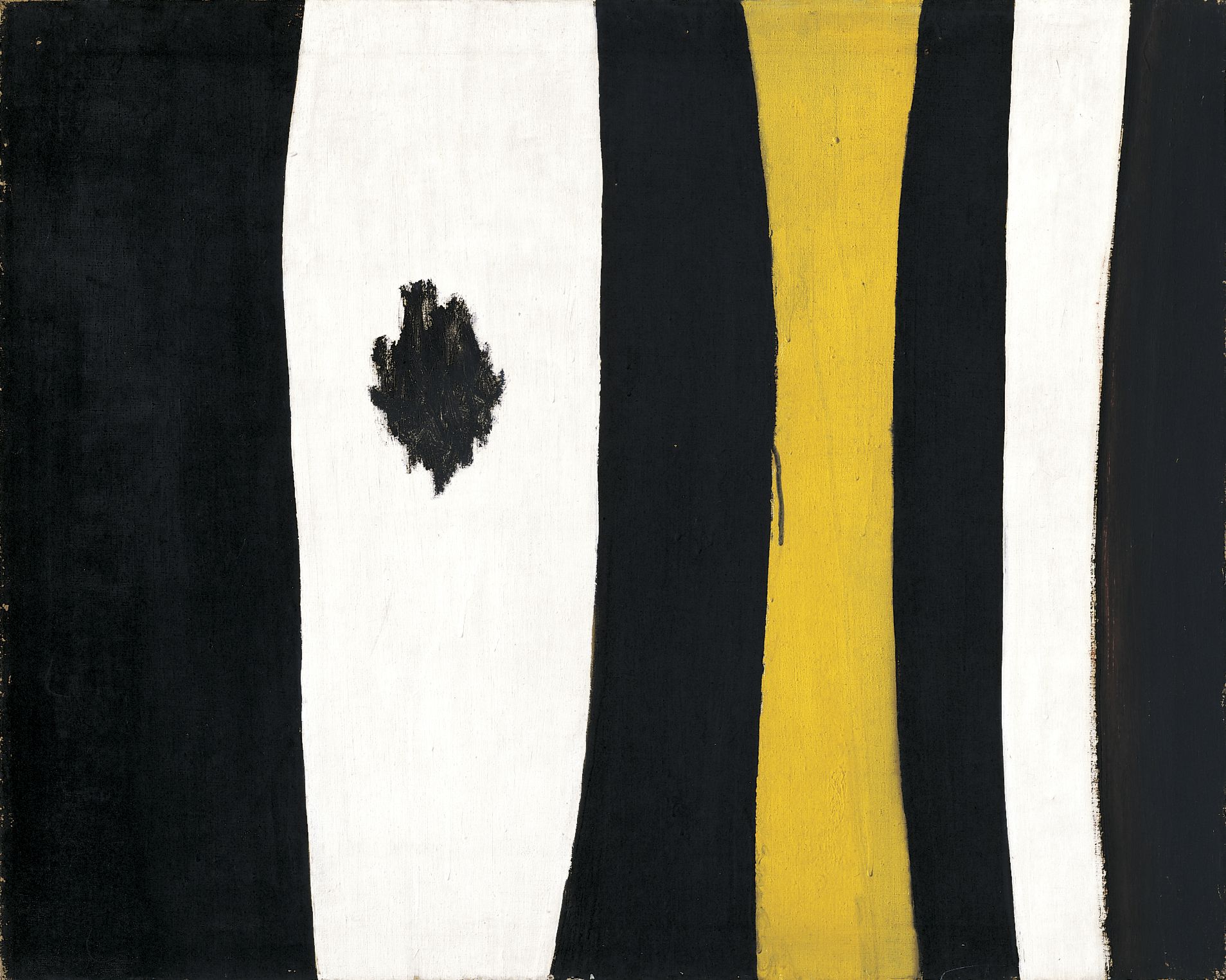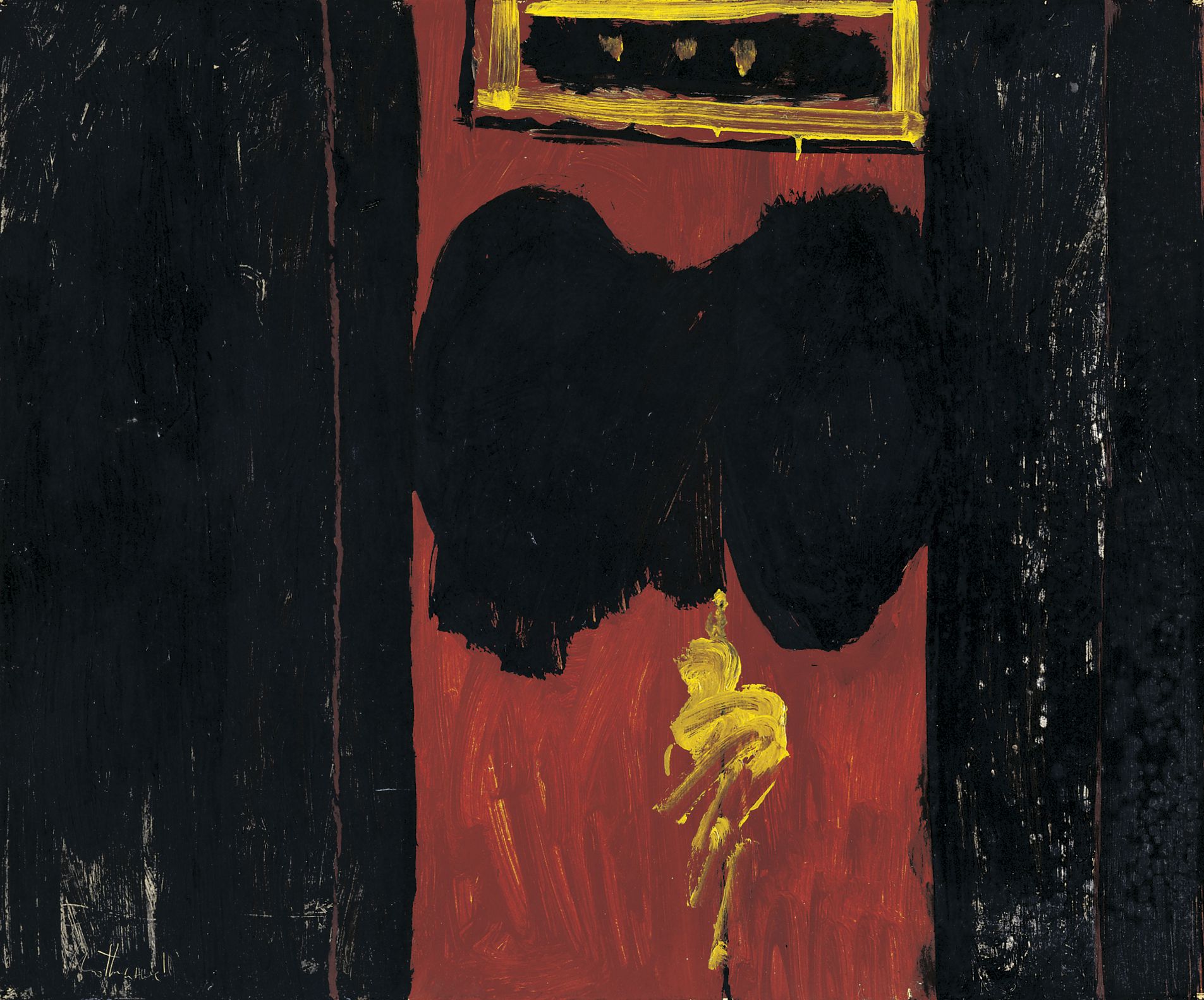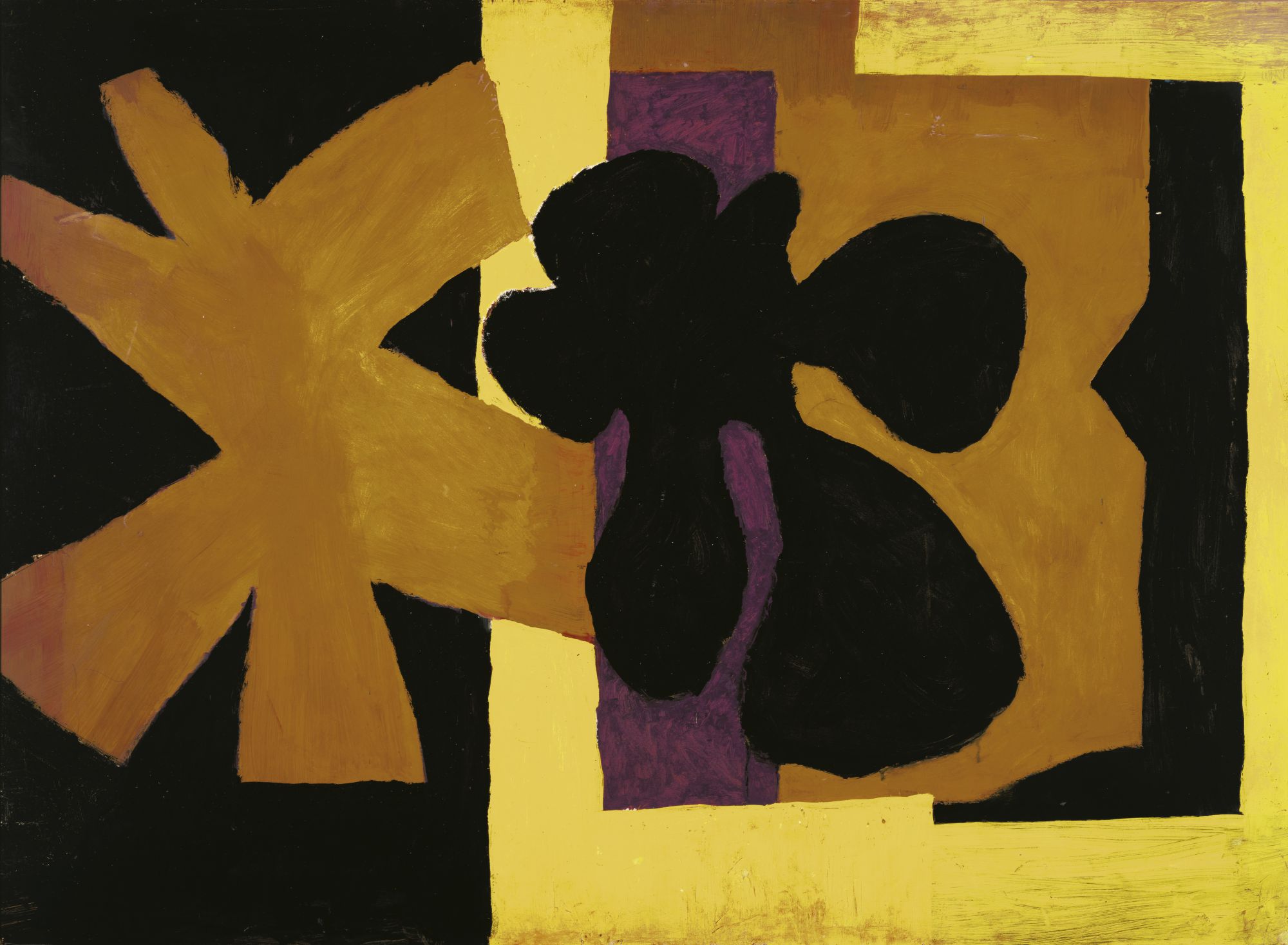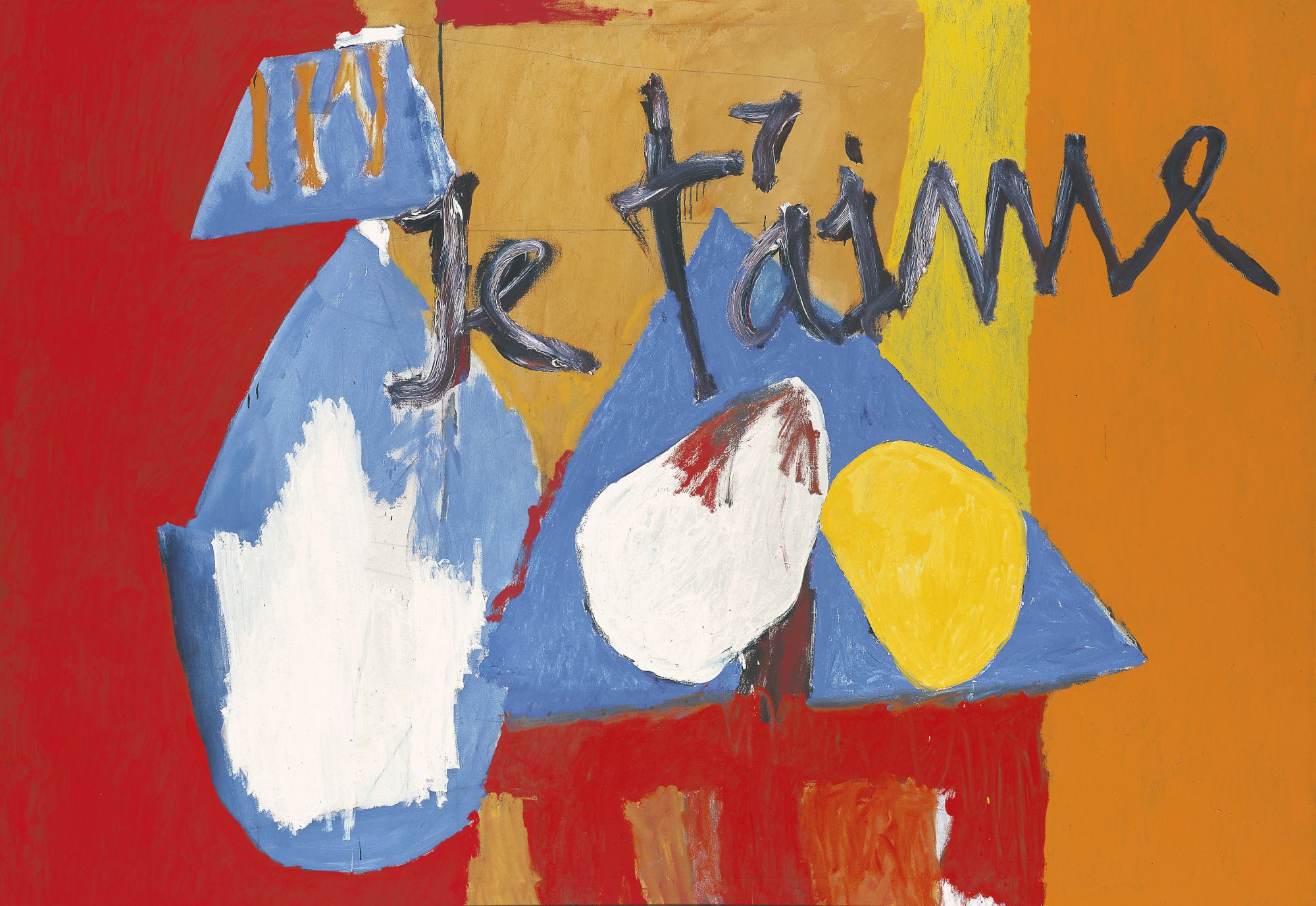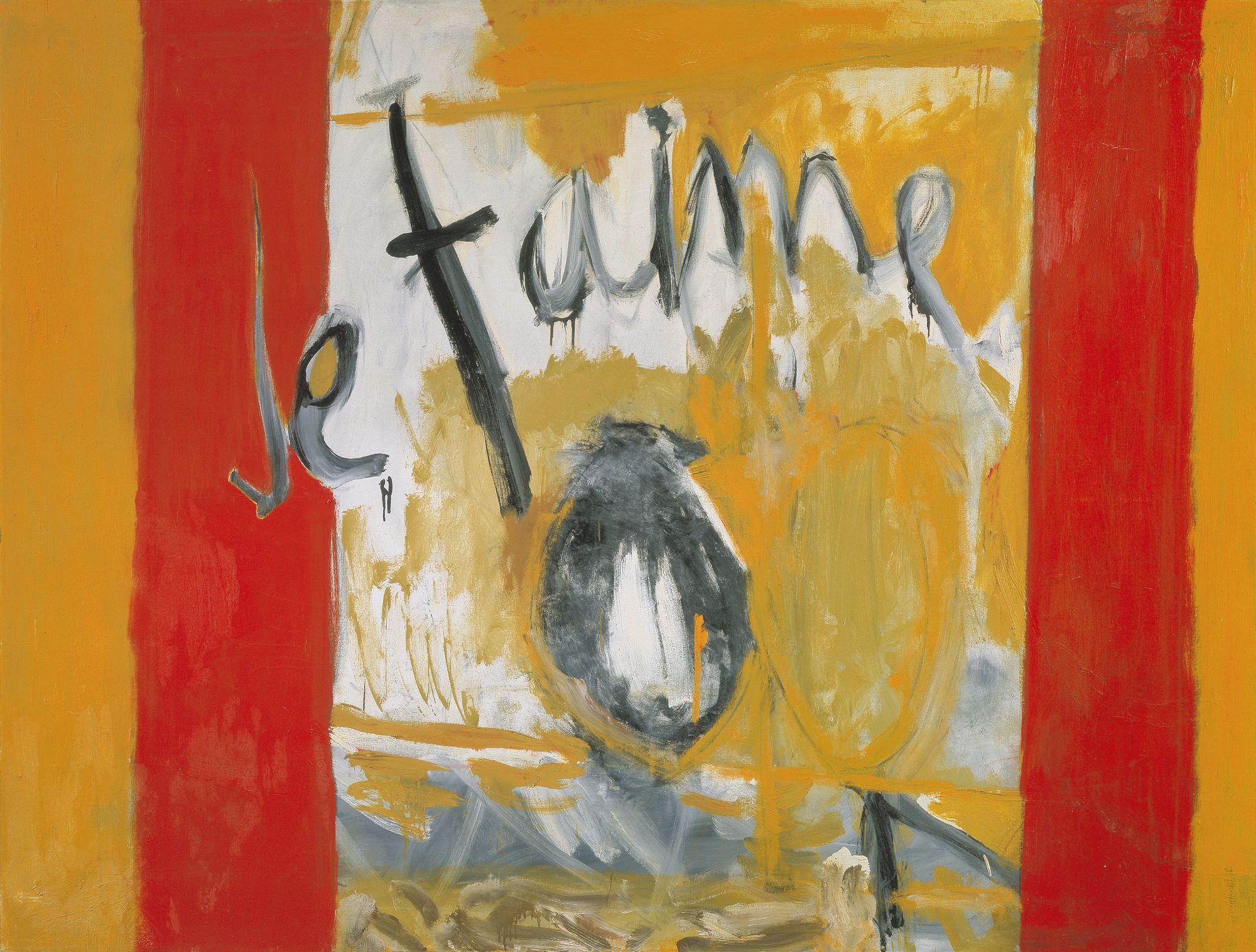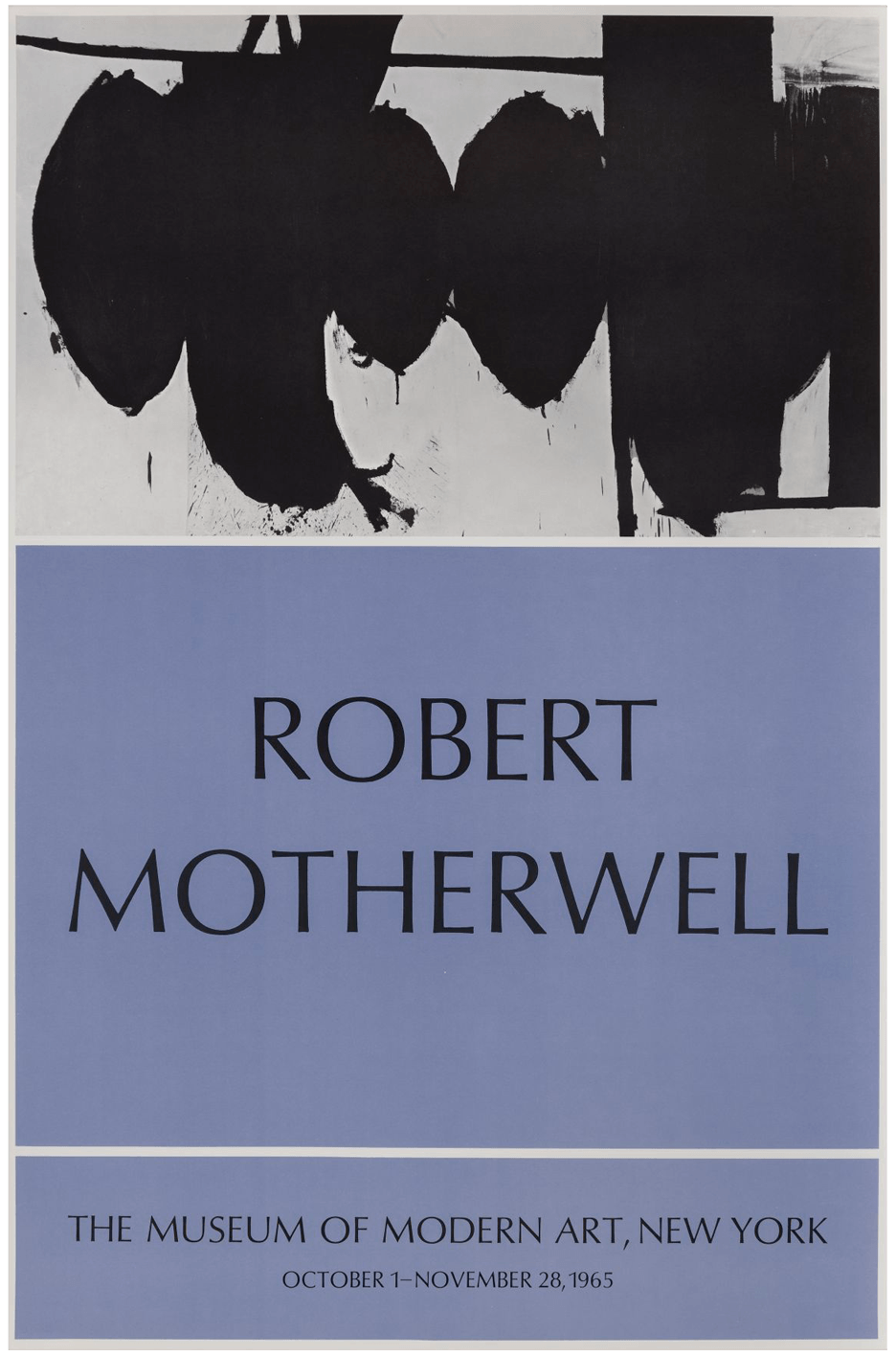Your browser is out-of-date!
Update your browser to view this website correctly. Update my browser now
1948 - 1957
The Elegies to the Spanish Republic and Variety of Imagery
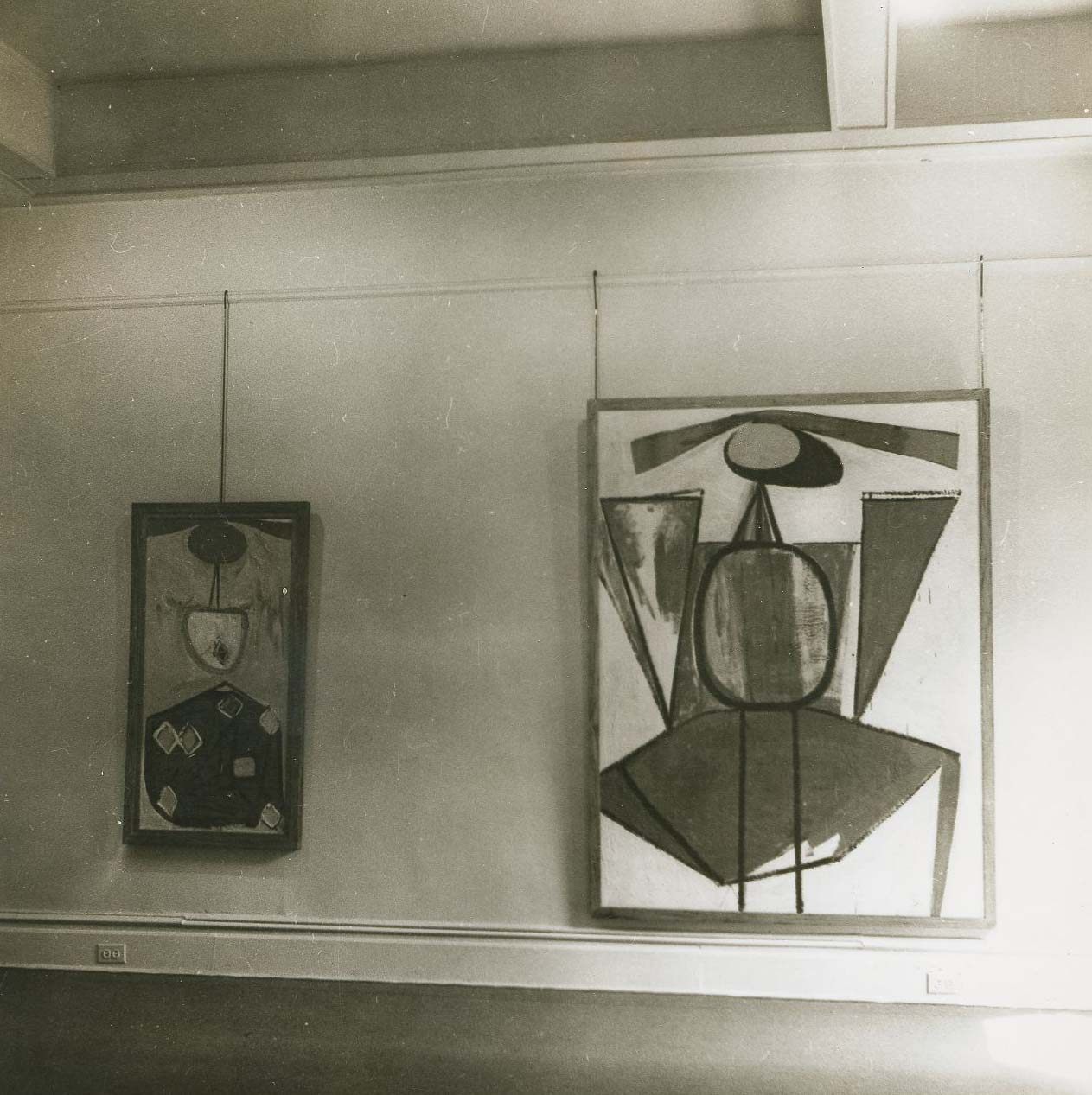
Installation view of Paintings and Collages by Motherwell at the Samuel M. Kootz Gallery, May 1948. From left to right: The Red Skirt and Personage, with Yellow Ochre and White
1948
In May, Paintings and Collages by Motherwell is shown at the Samuel M. Kootz Gallery. It consists of nineteen works created during the previous nine months. This is Motherwell’s most focused exhibition to date. Most of the paintings are large works depicting single figures, including The Red Skirt and Personage, with Yellow Ochre and White.

Elegy to the Spanish Republic No. 1, 1948
1948
In June, for the second issue of Possibilities, Motherwell creates a design to illuminate a violent poem by Harold Rosenberg, “A Bird for Every Bird.” This drawing contains the fully developed pictorial schema of what will become the Elegy to the Spanish Republic series, and he will later consider it to be the first work in the series.
1948
Samuel Kootz announces the closing of his gallery in order to work as Picasso’s exclusive worldwide dealer.
Motherwell, William Baziotes, and the other artists who depended upon the monthly stipend from the gallery are left without a steady source of income.
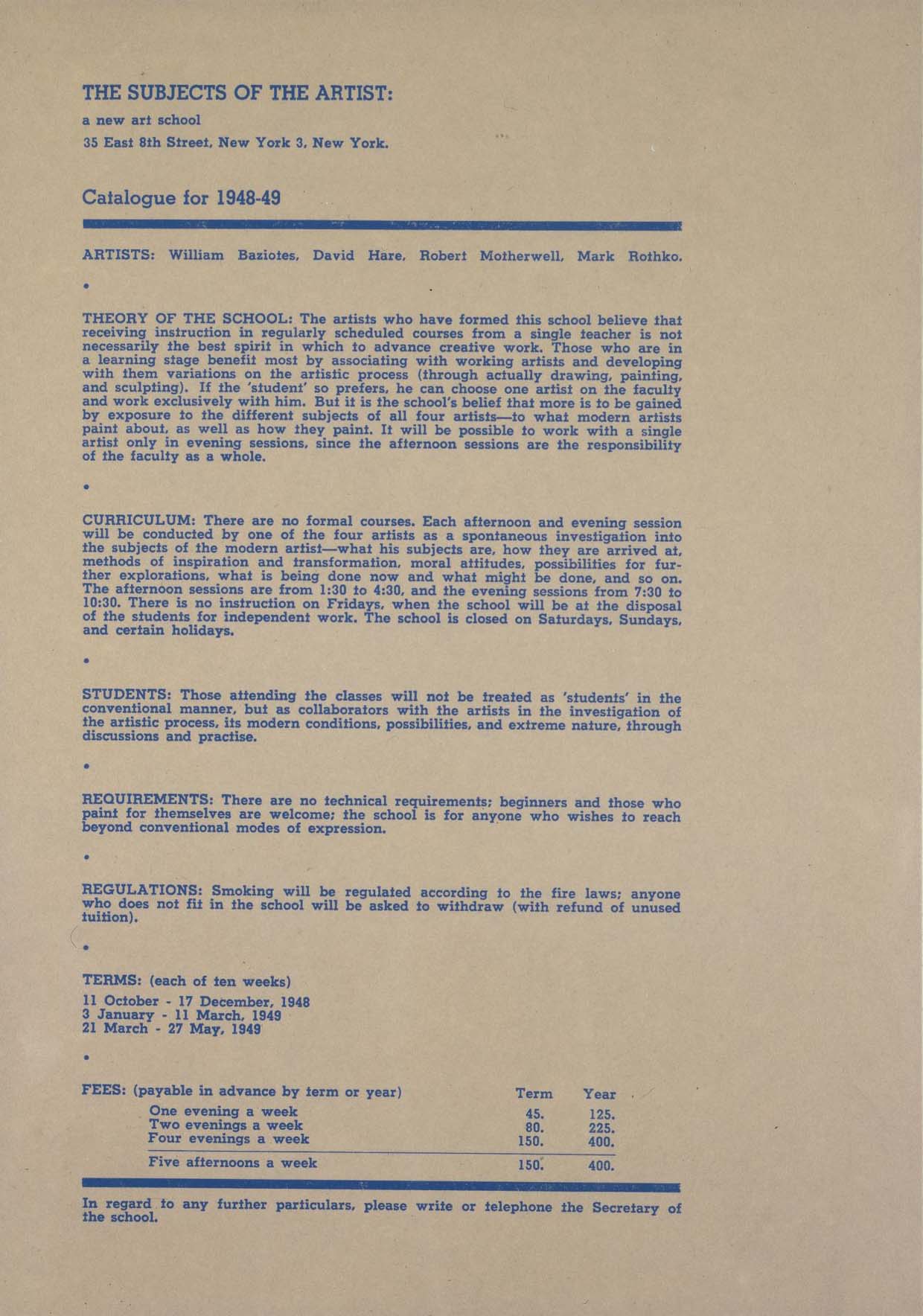
Poster announcing The Subjects of the Artist school, 1948
1948
In October, Motherwell moves back to New York, where Motherwell, Herbert Ferber, Ad Reinhardt, and Barnett Newman create The Subjects of the Artist school, which opens on October 11. The school’s name, suggested by Newman, is meant to emphasize that even the most abstract art has subjects. Nearly fifteen students enroll.
Motherwell organizes a series of Friday night talks by artists; among the first are Ferber and Reinhardt. When the talks prove more popular than expected, Motherwell asks Newman to help in their organization.
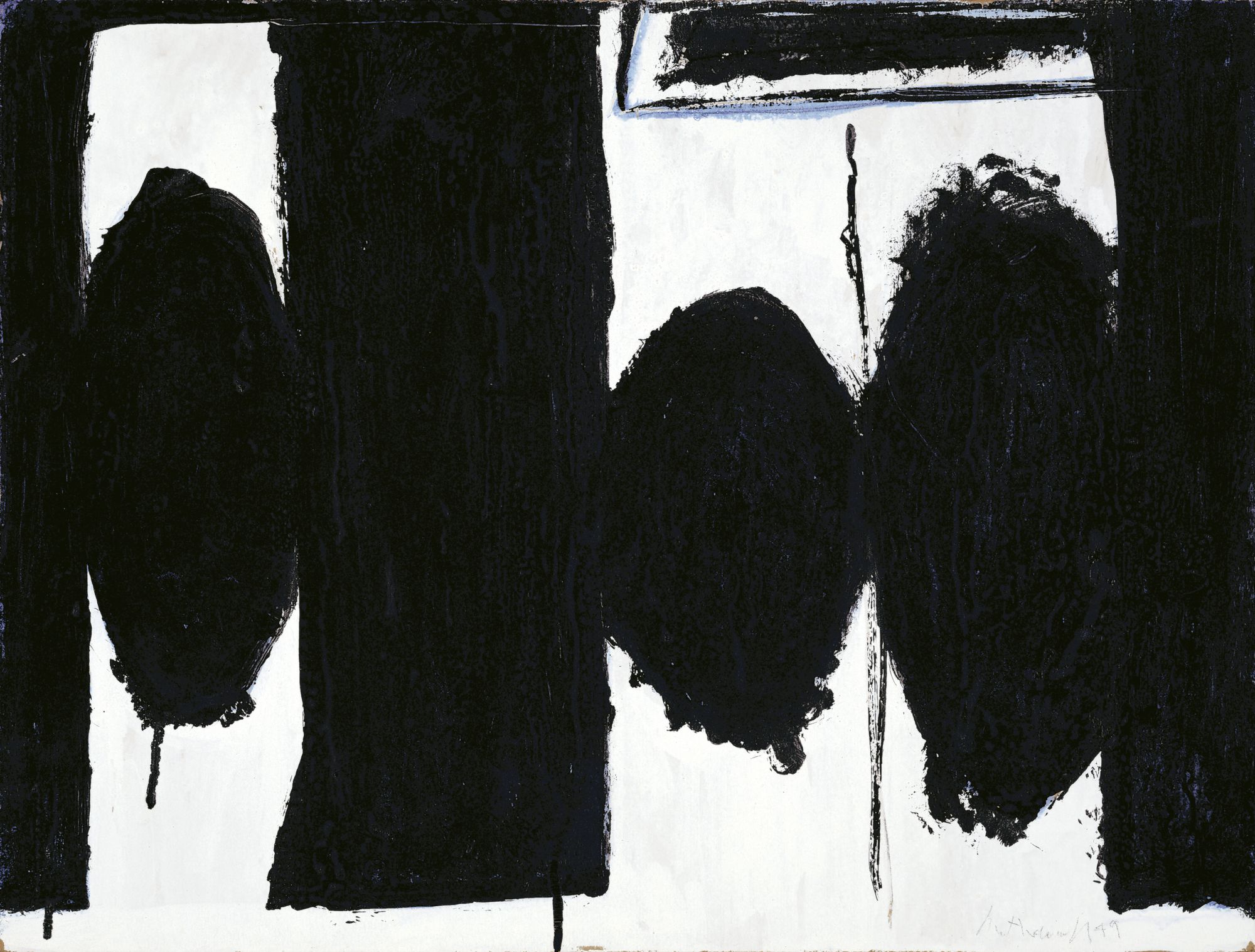
At Five in the Afternoon, 1948
Toward the end of the year, Maria Motherwell departs abruptly for California ending their marriage.
Motherwell falls into a deep depression and, while unpacking work he made in East Hampton, he rediscovers the drawing he made for Rosenberg’s poem. At the same time, Motherwell was reading the poetry of Federico García Lorca. He enlarges the black and white image in the drawing and gives the resulting painting the title At Five in the Afternoon, after Lorca’s famous poem commemorating the death of a bullfighter, “Llanto por Ignacio Sánchez Mejías.”
This small work is the first painted picture in the Elegy to the Spanish Republic series.
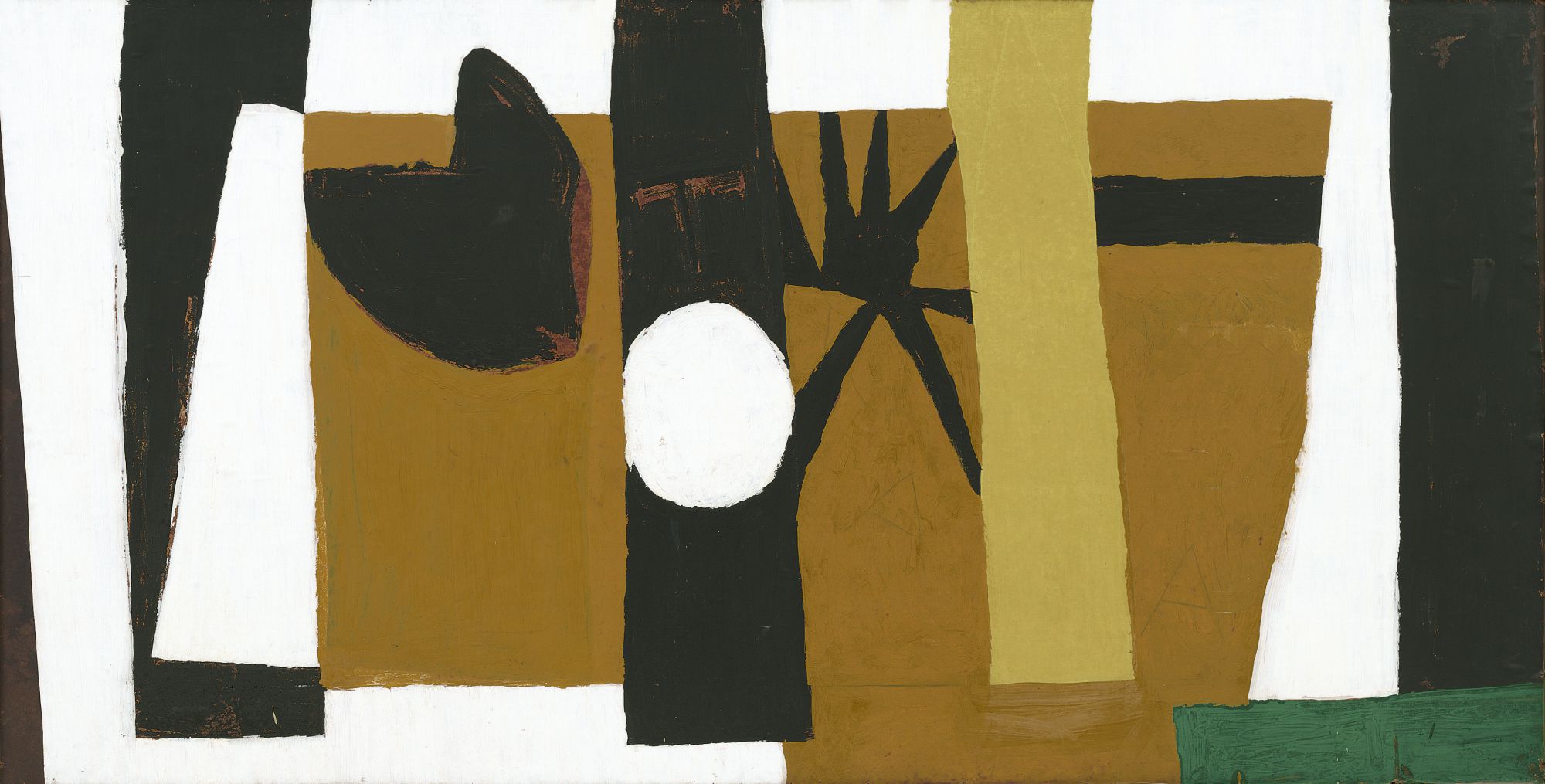
The Voyage, 1948–1949. Oil, tempera, and charcoal on paper mounted on Masonite, 48 x 94 inches (121.9 x 238.8 cm)
1948
During a blizzard, Motherwell paints Granada and The Voyage on a large roll of paper tacked to the wall. Still emotionally fragile after recent events, Motherwell considers destroying the new paintings, but Bradley Walker Tomlin talks him out of it.
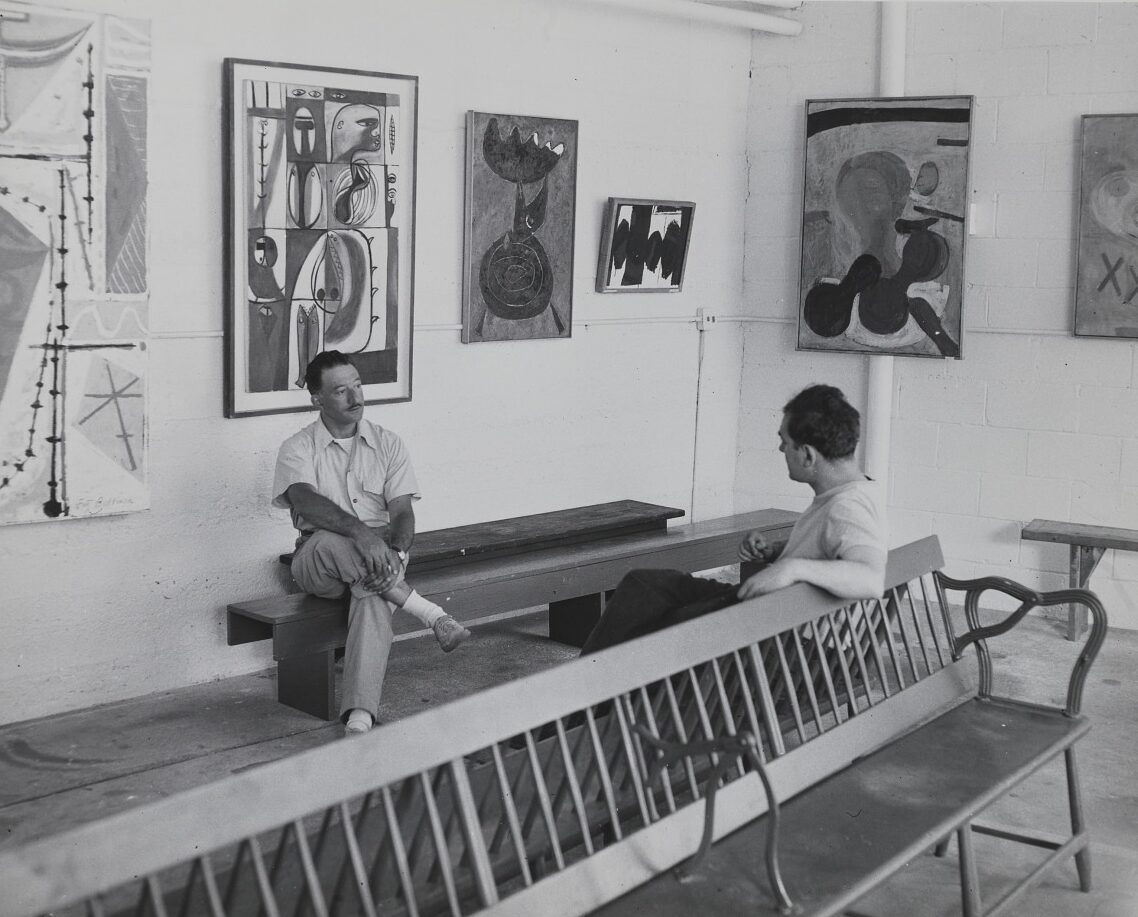
Installation view of Forum 49 at Gallery 200, July 1949. Motherwell’s At Five in the Afternoon is seen at right
1949
The Subjects of the Artist school closes in May.
In August, Motherwell travels to Provincetown with Willem de Kooning and delivers the talk “Reflections on Painting Now” as part of the Forum 49 symposium “French Art vs. U.S. Art Today.” The talk marks Motherwell’s first discussion of the concept of the “School of New York” in opposition to the “School of Paris.”
1949
In the fall, Motherwell rejoins the Samuel M. Kootz Gallery, which reopens at 600 Madison Avenue after a one-year hiatus. The gallery’s first exhibition is The Intrasubjectives. The catalogue features an essay by Rosenberg, and brings together the artists who will later become known as the Abstract Expressionists: Baziotes, de Kooning, Arshile Gorky, Adolph Gottlieb, David Hare, Hans Hofmann, Jackson Pollock, Reinhardt, Mark Rothko, and Motherwell.
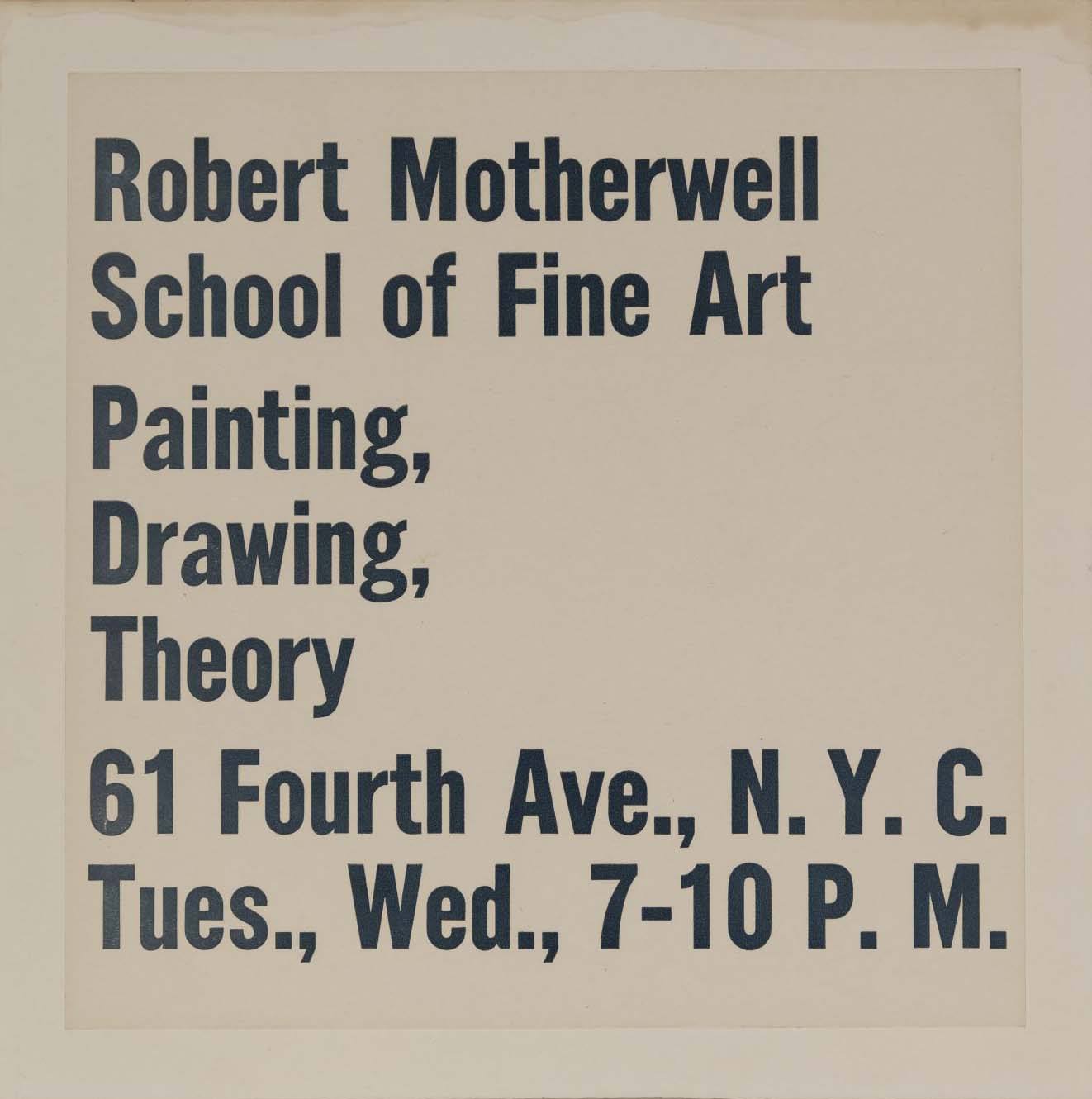
Advertisement for the Robert Motherwell School of Fine Art, 1949
1949
In the fall, the Robert Motherwell School of Fine Art opens in a loft at 61 Fourth Avenue. He holds classes twice a week and uses the space as his studio the remainder of the time. Shortly after the school opens, Tomlin begins sharing the studio with him. Tomlin introduces Motherwell to Philip Guston, who becomes a close friend.
1949
Motherwell travels to Reno, Nevada to obtain a divorce from Maria.
While there, he meets Betty Little, a woman from New York who will soon become his second wife.
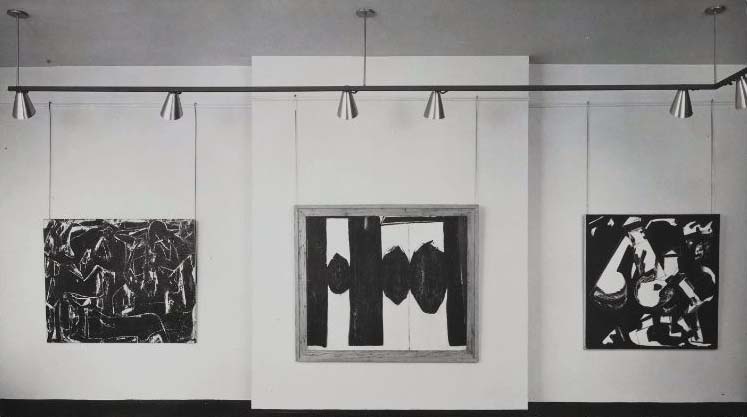
Installation view of Black or White: Paintings by Europen and American Artists at the Samuel M. Kootz Gallery, New York, January 1950. Motherwell’s Granada is seen at center
1950
Motherwell’s Granada is exhibited in January in the exhibition Black or White: Paintings by European and American Artists at the Samuel M. Kootz Gallery.
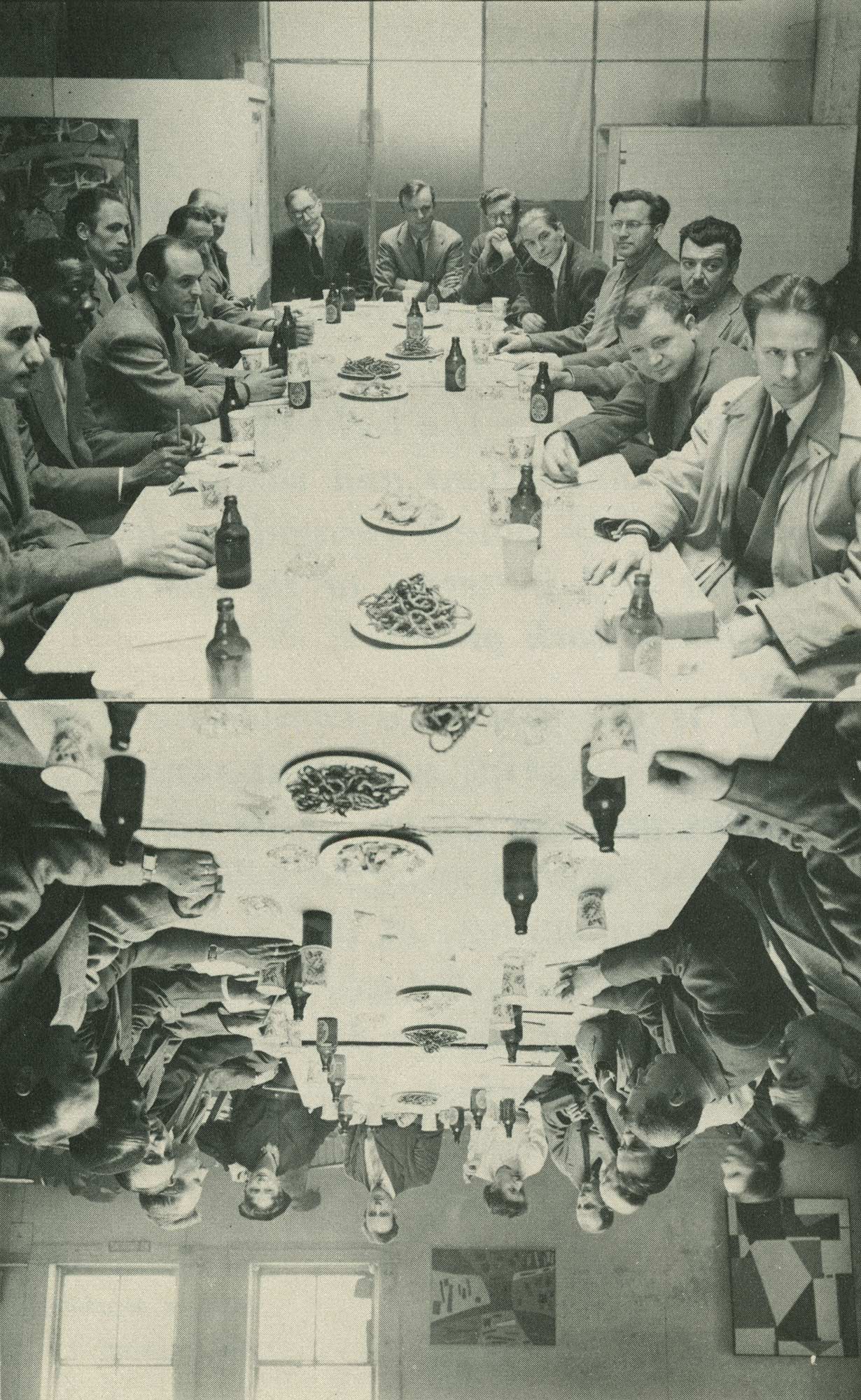
Participants in the “Artists’ Sessions at Studio 35,” New York, April 1950. Motherwell seated at top center
1950
Motherwell and Robert Goodnough moderate a three-day symposium, with twenty-five artists and Museum of Modern Art curator Alfred H. Barr, Jr. at Studio 35.
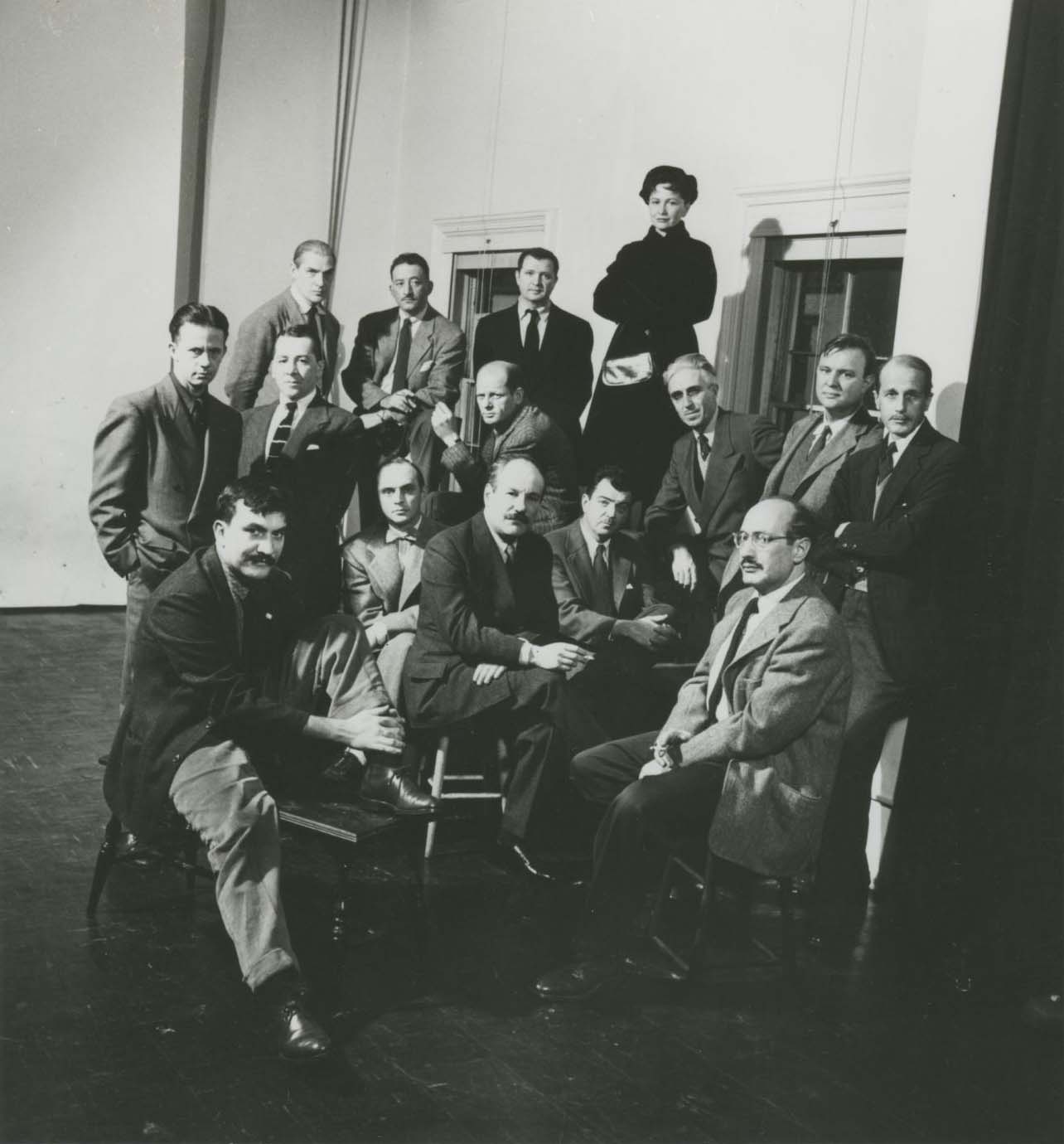
The Irascibles photographed for Life Magazine
1950
On May 22, Motherwell is among the eighteen artists who sign an “Open Letter to Roland Redmond,” published on the front page of the New York Times, protesting the conservatism of the Metropolitan Museum of Art’s juried exhibition American Painting Today. Emily Genauer dubs the artists “the Irascible 18” and the following January a group portrait of them appears in LIFE magazine.
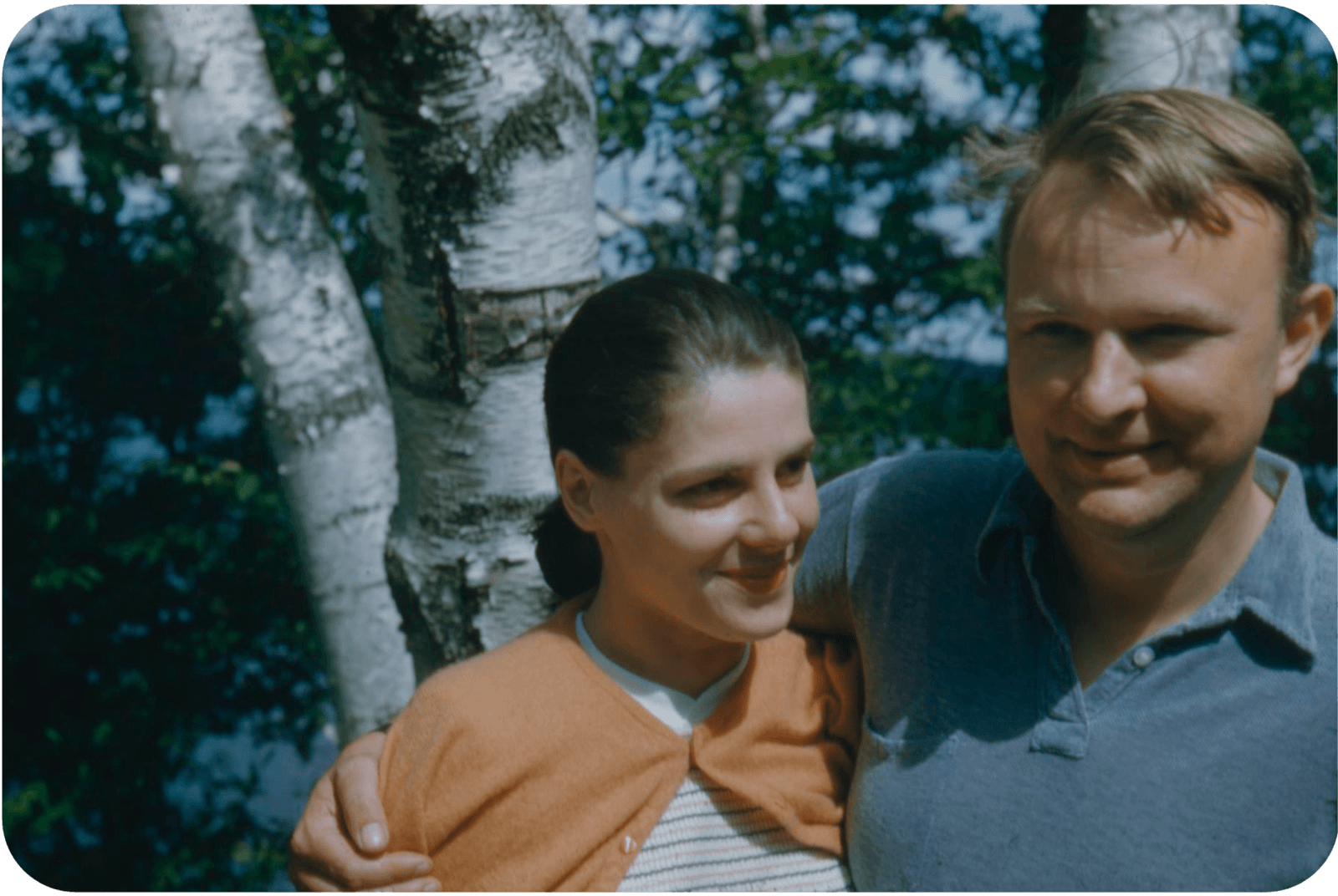
Photograph of Robert Motherwell and Betty Motherwell, ca. 1955
1950
On May 25, Motherwell marries Betty Little. She and her daughter Cathy move to East Hampton with him.
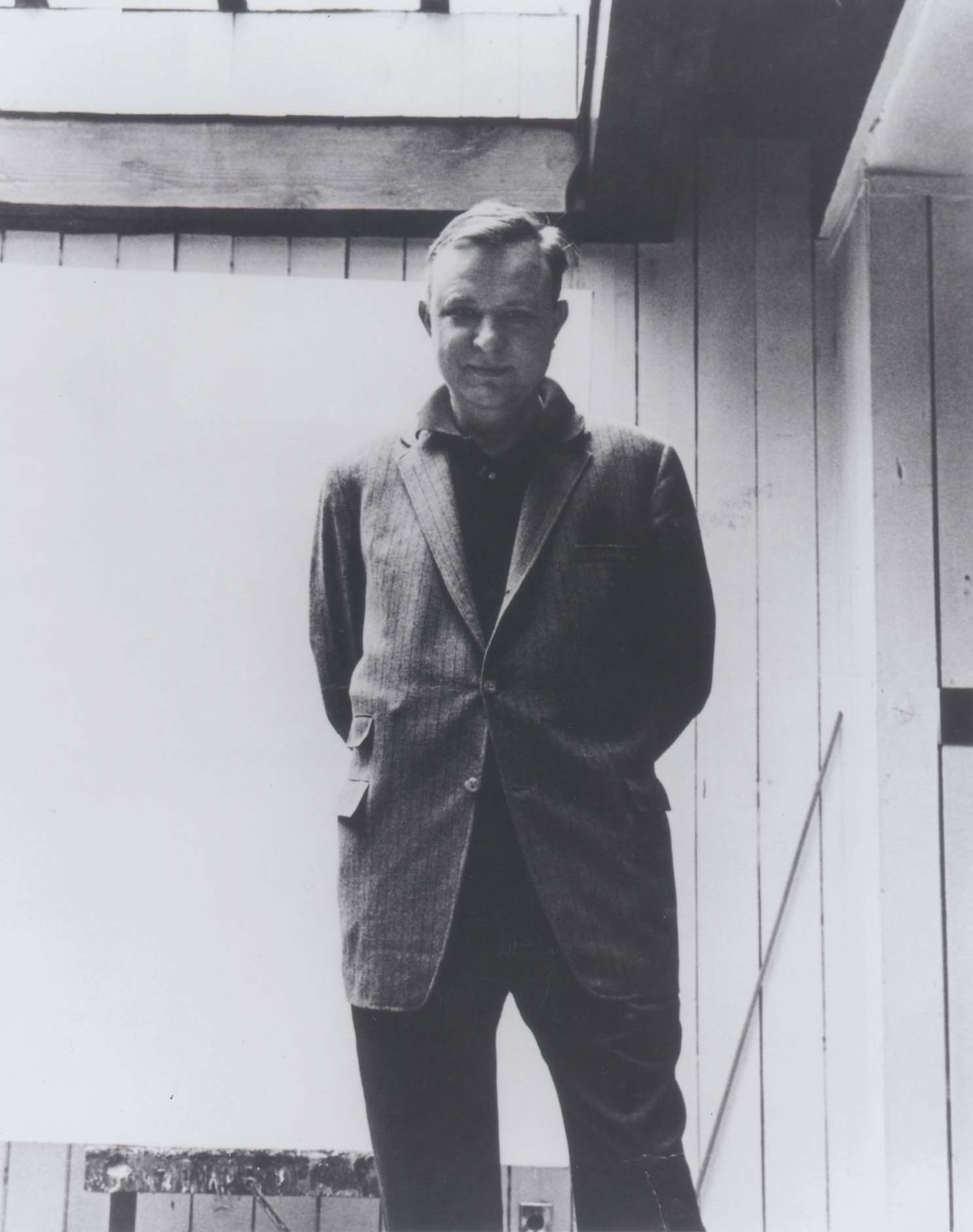
Motherwell in his East Islip, Long Island studio, 1951
1950
In September, Motherwell moves from East Hampton to East Islip on Long Island to be closer to New York City. He begins teaching private classes at his studio and stays over several nights a week in New York.
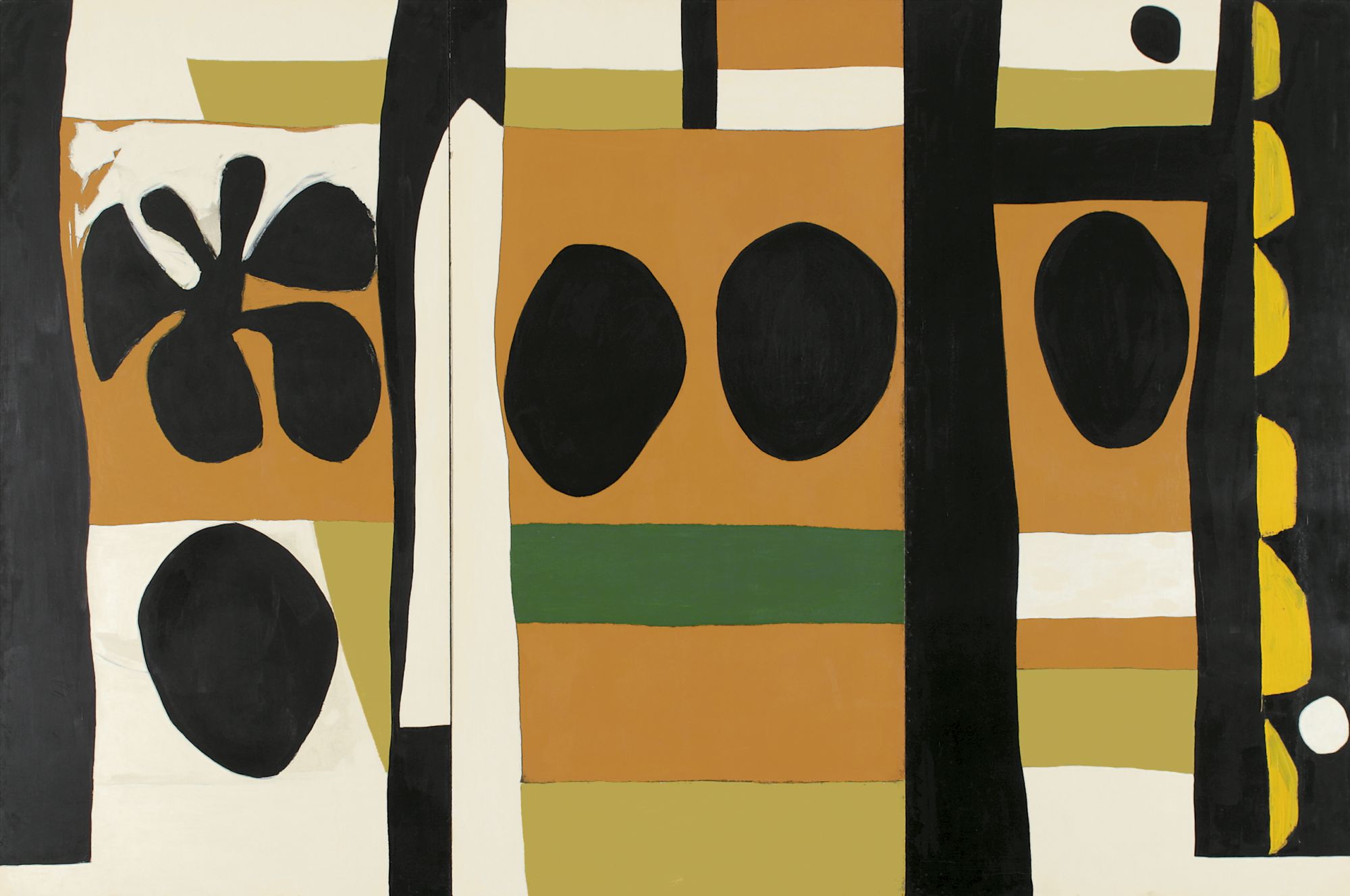
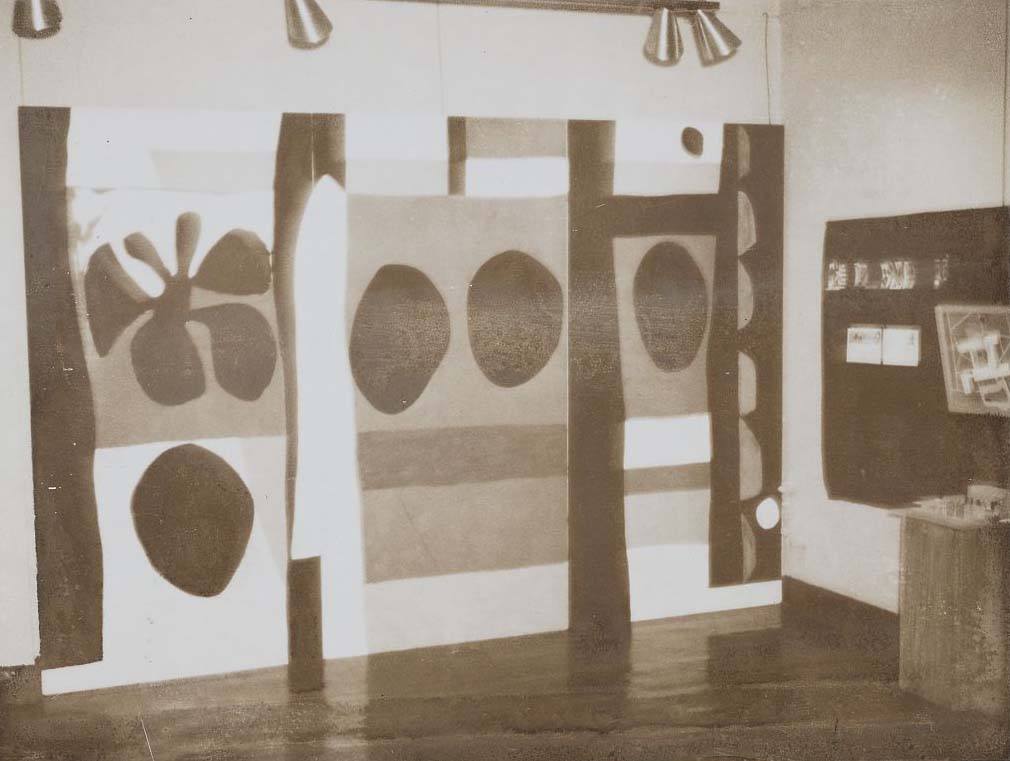
1950
In October, the Samuel M. Kootz Gallery presents an exhibition of collaborations between gallery artists and noted architects, including Walter Gropius. Motherwell works with the Architects Collaborative, a firm led by Gropius. He exhibits a maquette for a sixty-foot long mural he conceived for a junior high school in Attleboro, Massachusetts along with Mural Fragment, a triptych of three 8-by-4-foot Masonite panels based on a small section of the maquette.
1950
Later that month, Motherwell delivers a lecture, “The New York School,” at the Midwestern College Art Conference in Louisville, Kentucky. The lecture is the most cogent critical discussion to date of the new art being developed in New York.
1950
On November 14, Motherwell: First Exhibition of Paintings in Three Years opens at the Samuel M. Kootz Gallery. It presents the first exhibition of the group of paintings Motherwell calls the “Elegies (To The Spanish Republic),” including Barcelona. Two other recent groups of paintings are also exhibited: “Capriccios” and “Wall Paintings.”
In December, Motherwell accepts a commission to paint a mural for a synagogue in Millburn, New Jersey, to be designed by the architect Percival Goodman. In preparation for painting the mural, Motherwell researches the history of Jewish art and iconography.
1951
Seventeen Modern American Painters is exhibited at the Frank Perls Gallery, Beverly Hills, from January 11 to February 7. The exhibition catalogue features Motherwell’s essay “The New York School.”
In February, Motherwell joins the Graduate Department of Art and Art History at Hunter College. He will be made an assistant professor in 1952, granted tenure in 1953, and will teach at Hunter through 1959. He is instrumental in making Hunter one of the earliest graduate programs to teach modern art, and brings many artists onto the faculty, including Baziotes, Richard Lippold, Reinhardt, and Clyfford Still.
In May, Motherwell moves back to New York to be closer to Hunter College.

Motherwell teaching at Black Mountain College, Asheville, N.C., summer 1951
1951
In August, Motherwell teaches the summer session at Black Mountain College, near Asheville, North Carolina. Motherwell’s students include Robert Rauschenberg and Cy Twombly. Shortly after meeting Twombly, Motherwell writes Kootz and recommends that he give the young artist an exhibition in New York.
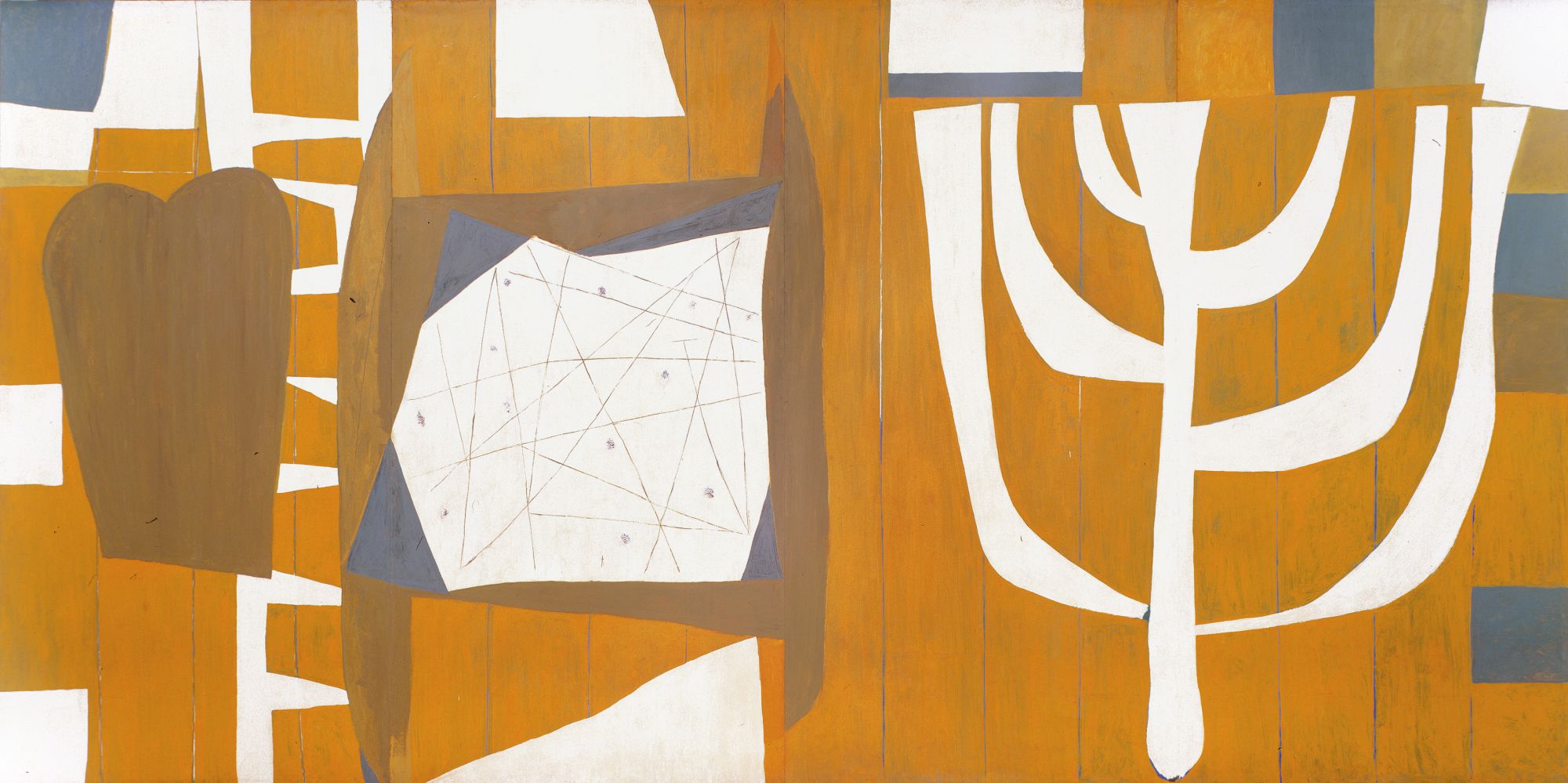
The Wall of the Temple, 1951. Oil on Masonite, 96 x 192 inches (243.8 x 487.7.cm)
1951
In October, Art for a Synagogue is shown at the Samuel M. Kootz Gallery. The exhibition features Percival Goodman’s designs for Congregation B’nai Israel synagogue in Millburn, New Jersey, and the artworks commissioned for it by Ferber, Gottlieb, and Motherwell, whose eight-by-sixteen foot mural for the building, The Wall of the Temple, is installed the following spring.
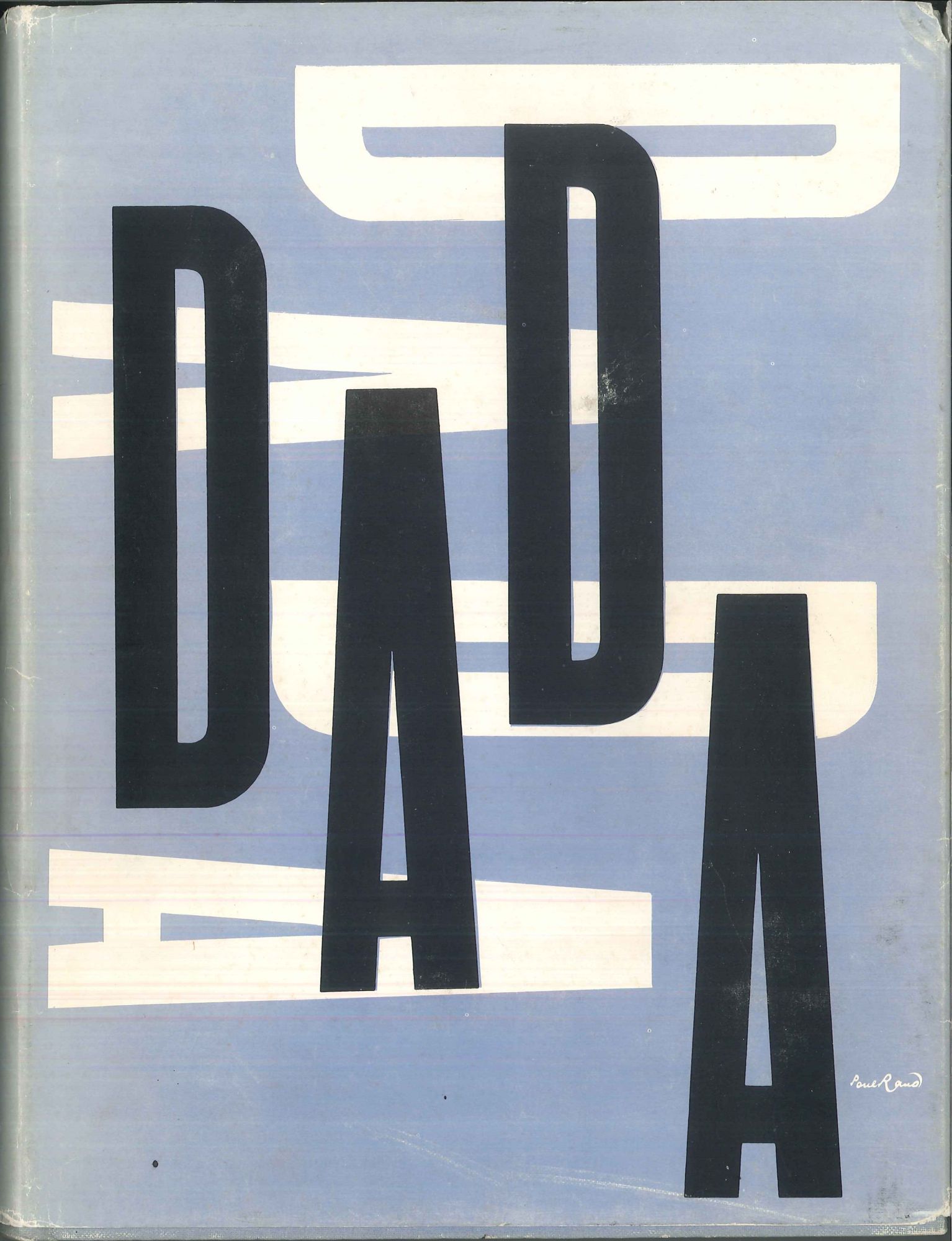
Motherwell’s copy of The Dada Painters and Poets
1951
In November, The Dada Painters and Poets is published in the Documents of Modern Art series, after seven years of research by Motherwell. The book is immediately heralded as an art-historical landmark and will exert a strong influence on the art of the following decades.
1951
Cy Twombly’s first exhibition is held at the Seven Stairs Gallery and Bookstore in Chicago. Motherwell writes the catalogue essay for the show, stating, “I believe Cy Twombly is the most accomplished young painter whose work I happen to have encountered.”
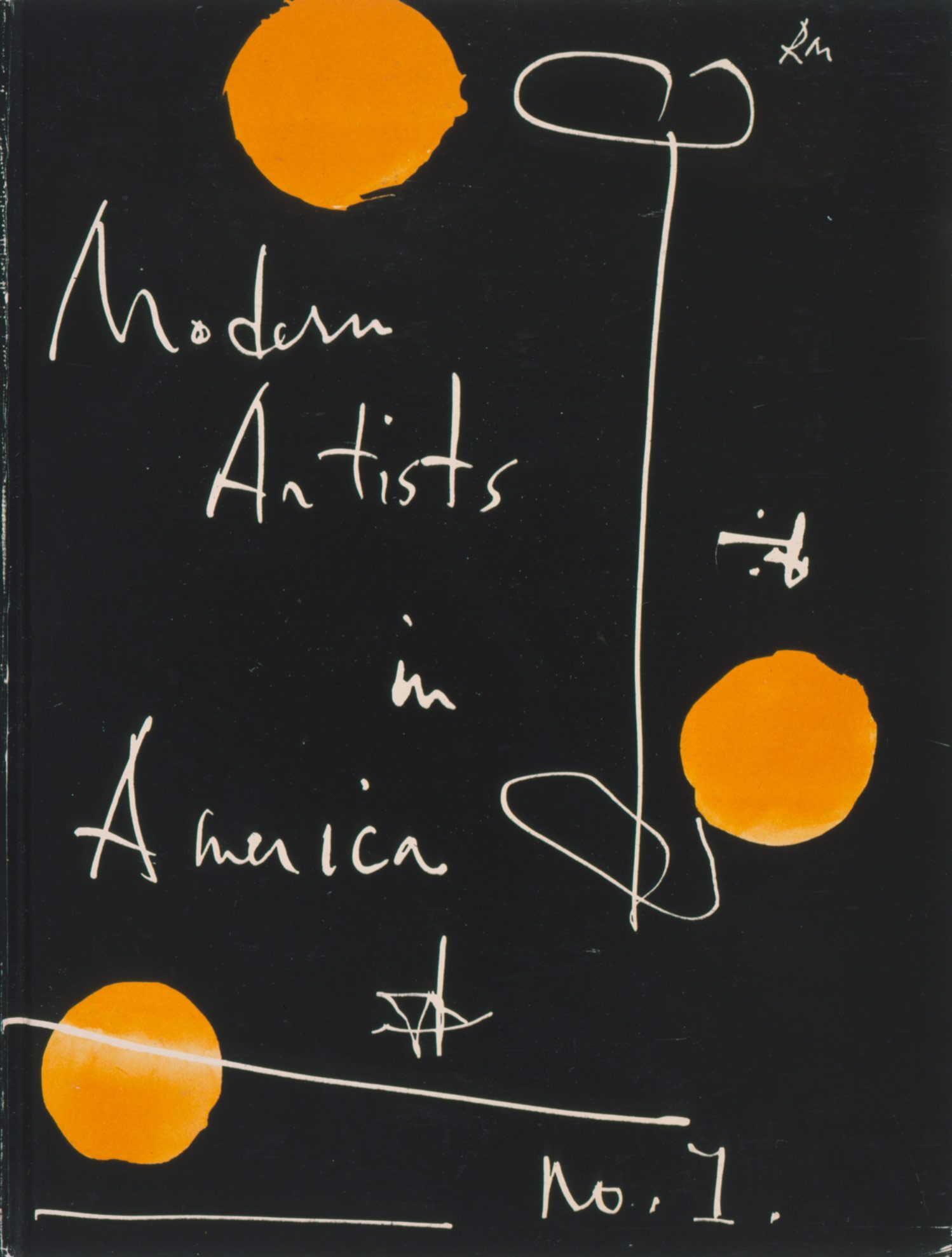
Motherwell’s cover design for Modern Artists in America
1951
Modern Artists in America, edited by Motherwell, Reinhardt and Bernard Karpel is published by Wittenborn, Schultz, Inc. The volume is a documentary account of the 1949—50 art season and features transcripts of “The Artists’ Sessions at Studio 35” and “The Western Round Table of Modern Art,” among other texts.
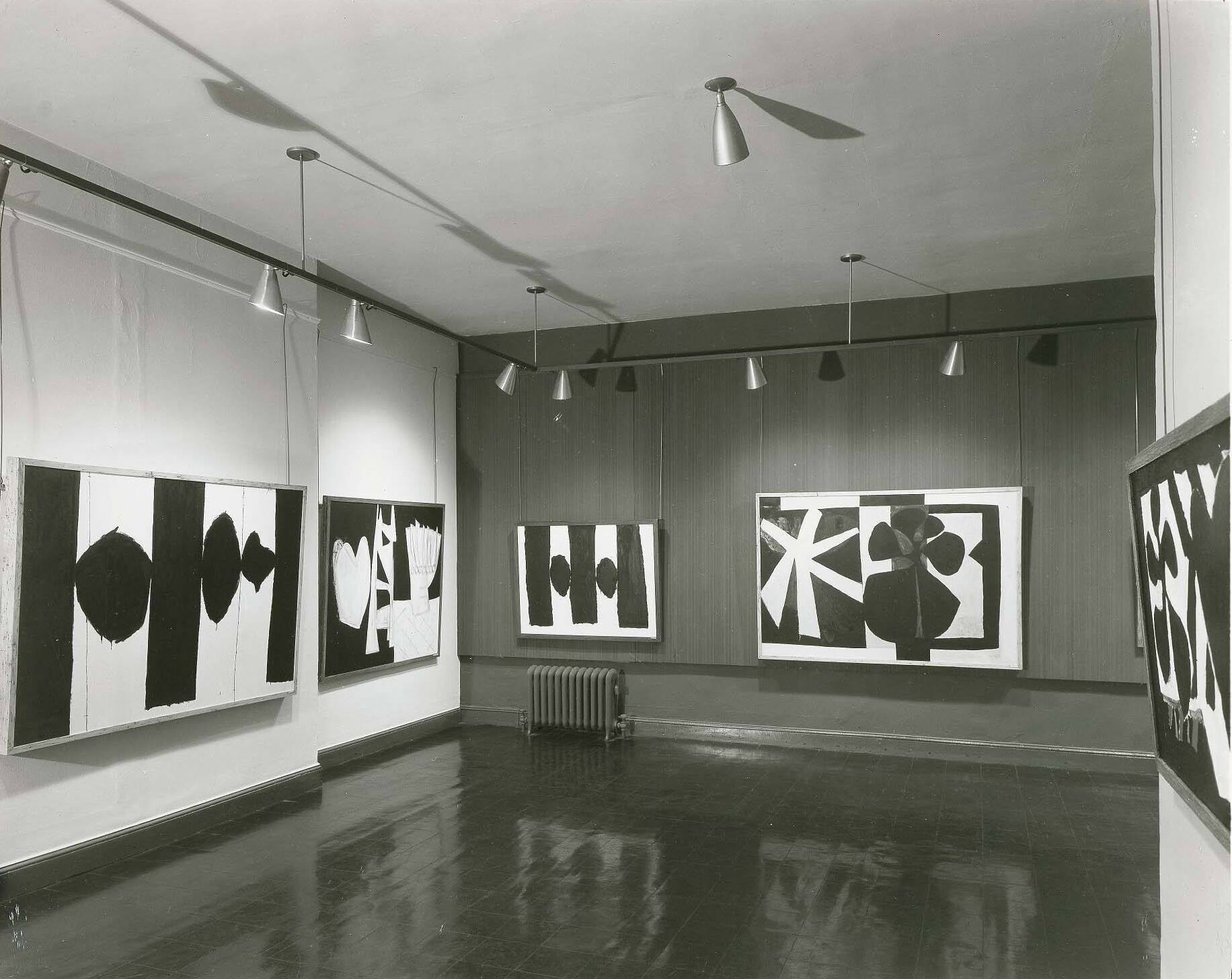
Installation view of Robert Motherwell: Paintings, Drawings, and Collages at the Samuel M. Kootz Gallery, New York, April 1952. From left to right: Castile (España), Decalogue, Jacob’s Ladder, and Burning Bush, Andújar (España), Wall Painting III, and La Danse
1952
In April, Robert Motherwell: Paintings, Drawings, and Collages is exhibited at the Samuel M. Kootz Gallery. The exhibition includes five new paintings in the Elegy to the Spanish Republic series.
1952
Motherwell spends the summer in East Hampton. On June 30, a letter by seven members of the “Irascible” group is published in the New York Times protesting, once again, the Metropolitan Museum of Art’s dismissive attitude towards modern art in its juried exhibitions.
Motherwell meets the poet Frank O’Hara, with whom he will collaborate on a number of projects.
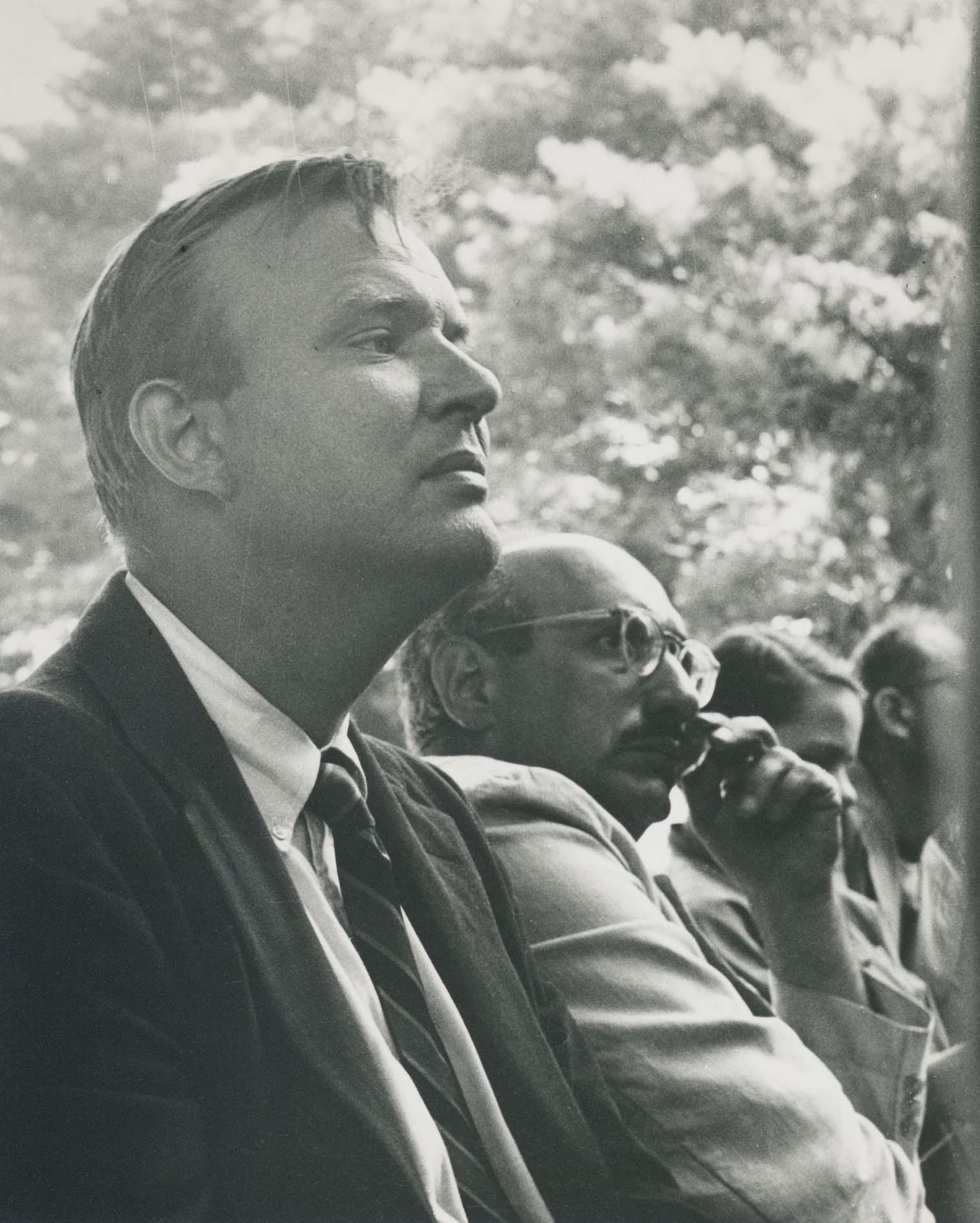
Motherwell and Rothko at the “Aesthetics and the Artist” Conference in Woodstock, N.Y., 1952
1952
Motherwell speaks at the “Aesthetics and the Artist” seminar in Woodstock, New York, organized by the Artists Equity Association. Other speakers include Newman, Rothko, and David Smith.
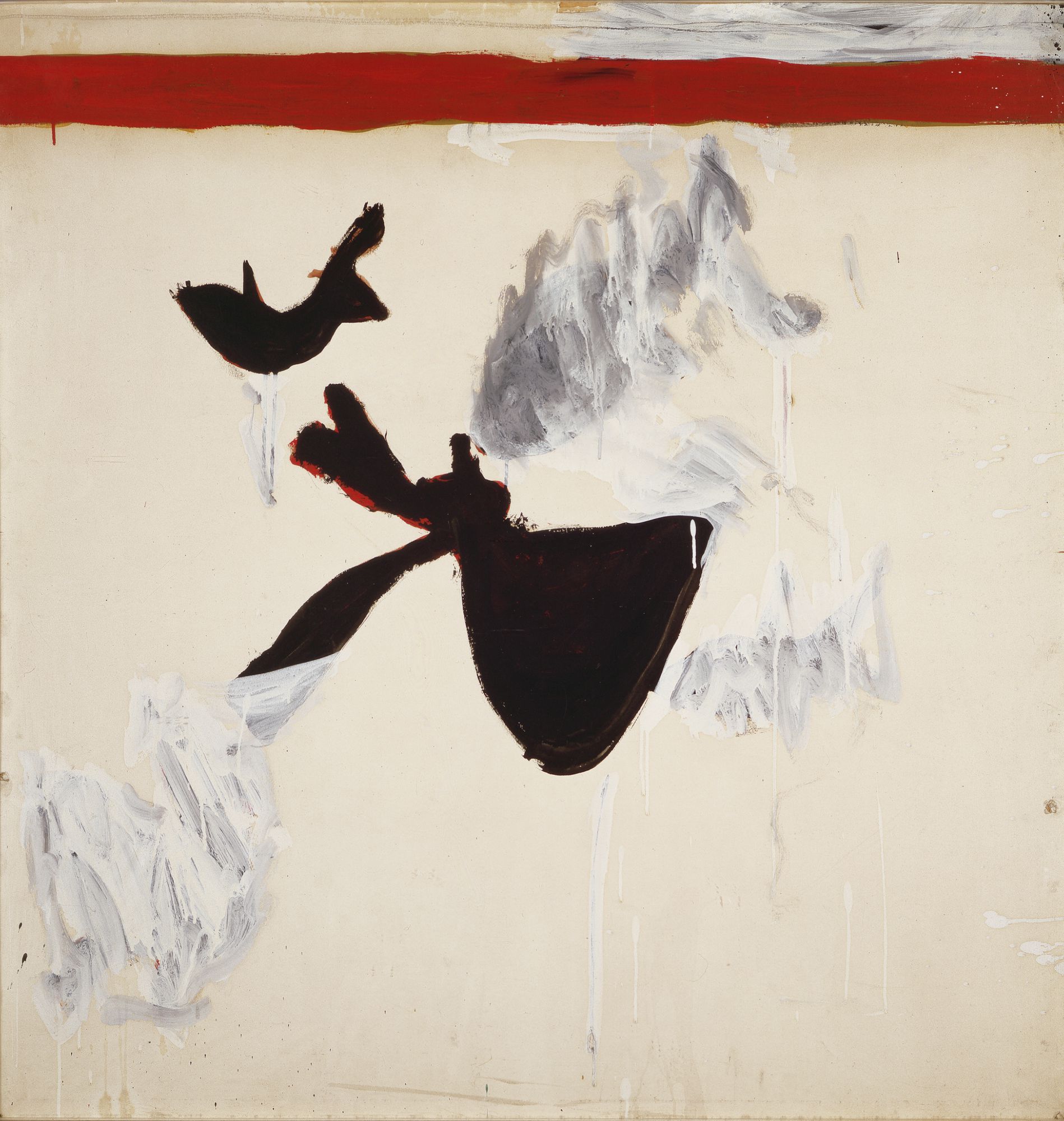
Fishes with Red Stripe, 1952
1952
Toward the end of the year, Motherwell accepts a commission for an 18-by-7-foot tapestry to be installed in a new synagogue in Springfield, Massachusetts. His work on the tapestry inspires several new paintings including Fishes with Red Stripe.
1953
On January 28, Motherwell’s daughter Jeannie is born.
In April, Motherwell purchases a three-story brownstone at 174 East Ninety-fourth Street, where he will live until 1971.
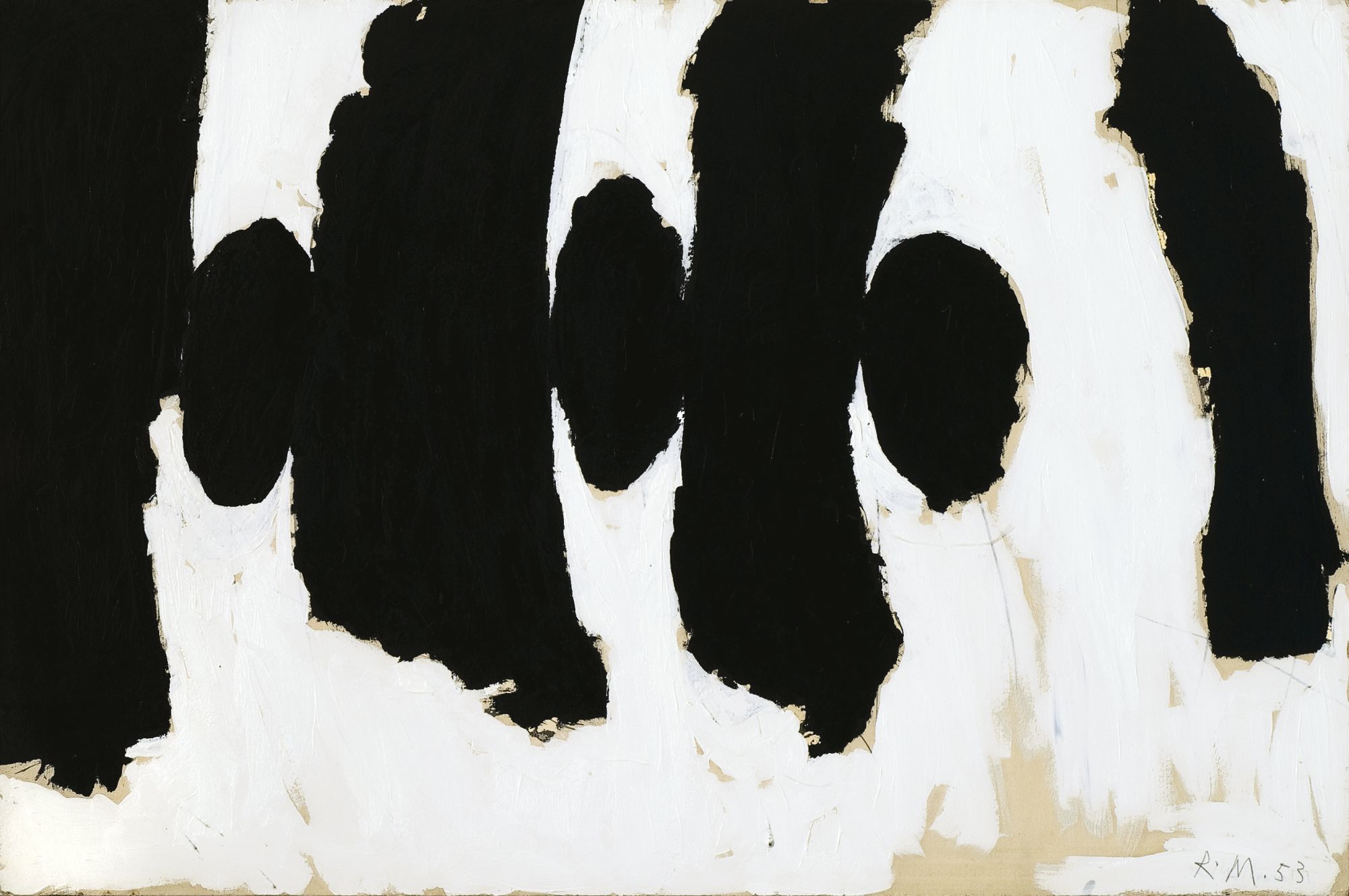
Spanish Elegy XIV (Palamos), 1953. Oil and graphite on paperboard, 20 x 30 inches (50.8 x 76.2 cm)
1953
In April, Motherwell exhibits five small Elegy paintings at the Samuel M. Kootz gallery, including Spanish Elegy XIV (Palamos), along with his first major series of collages since the late 1940s.
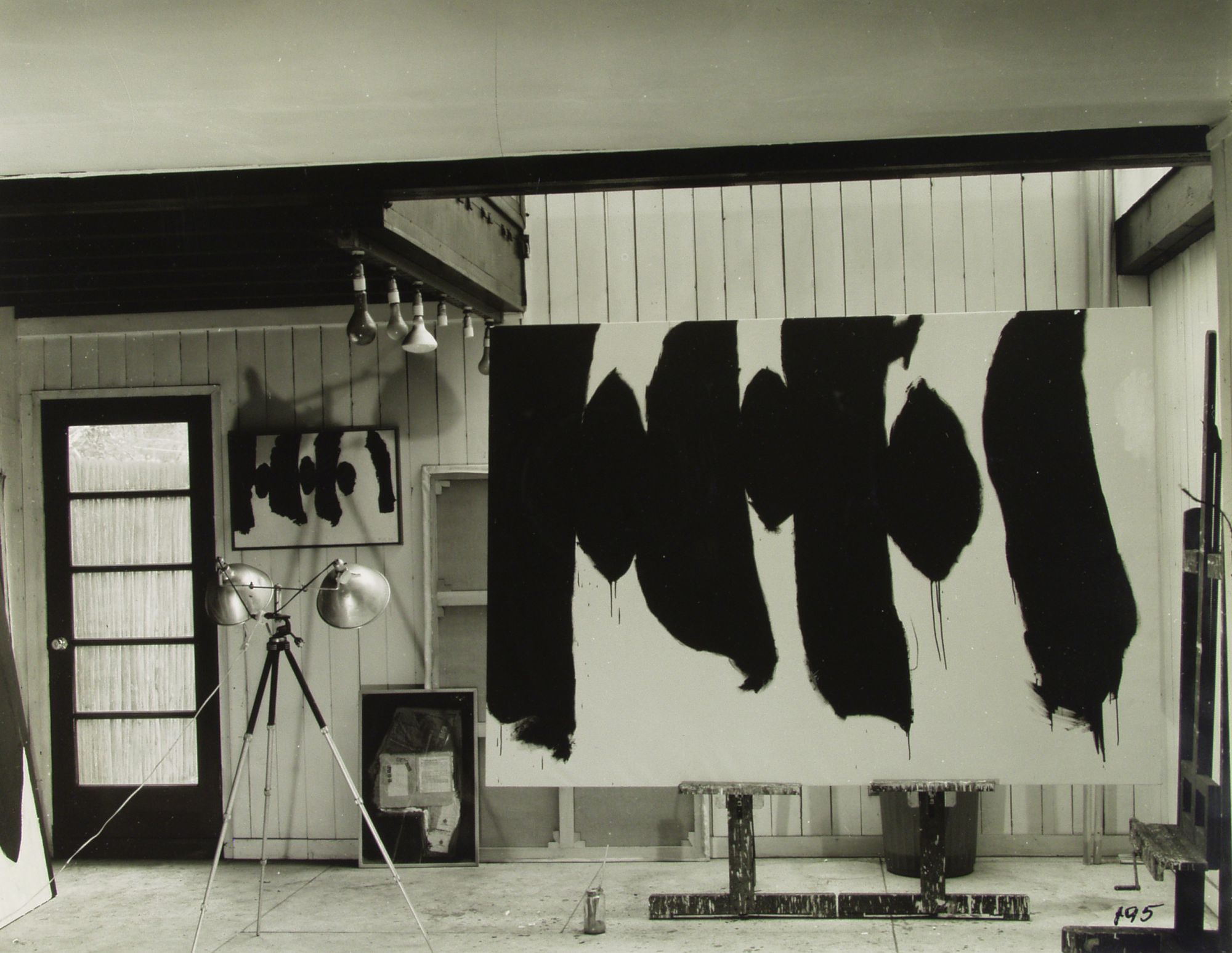
Motherwell’s studio at 173 E. 94th Street, New York. From left to right: Spanish Elegy XIV (Palamos) and an early state of Diary of a Painter, 1958
1953
In his house on East 94th Street, Motherwell paints some of his most iconic works—a series of large-scale canvases, including Diary of a Painter.
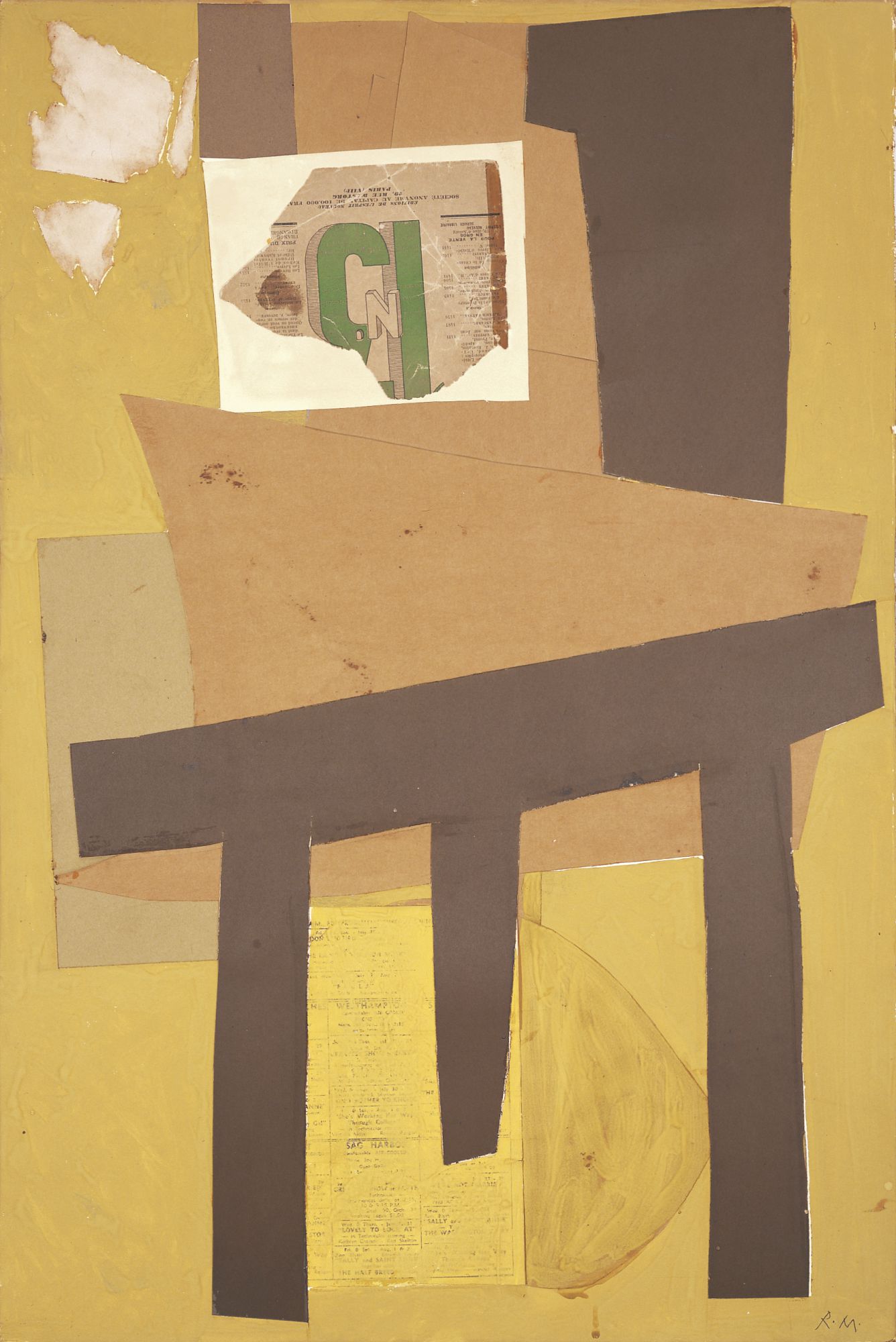
The Easel I, 1952
1953
The Easel I and four drawings are included in II Bienal do Museu de Arte Moderna, São Paulo, in December.
On December 27, Motherwell sells his Chareau-designed house in East Hampton to Barney Rossett, the owner of Grove Press.
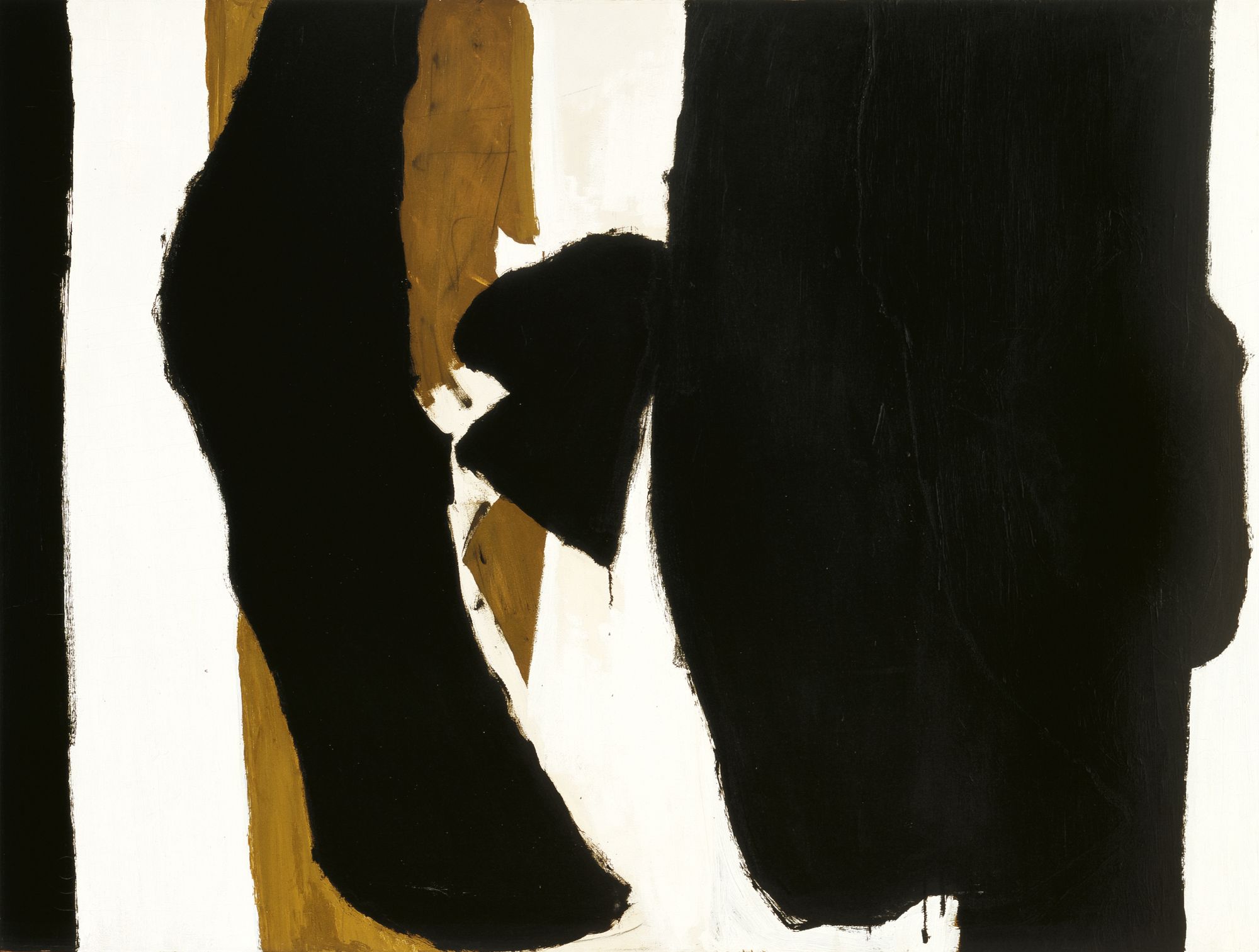
Wall Painting IV, 1954
1954
Younger American Painters: A Selection, which opens on October 17 at the Solomon R. Guggenheim Museum, includes Wall Painting IV.
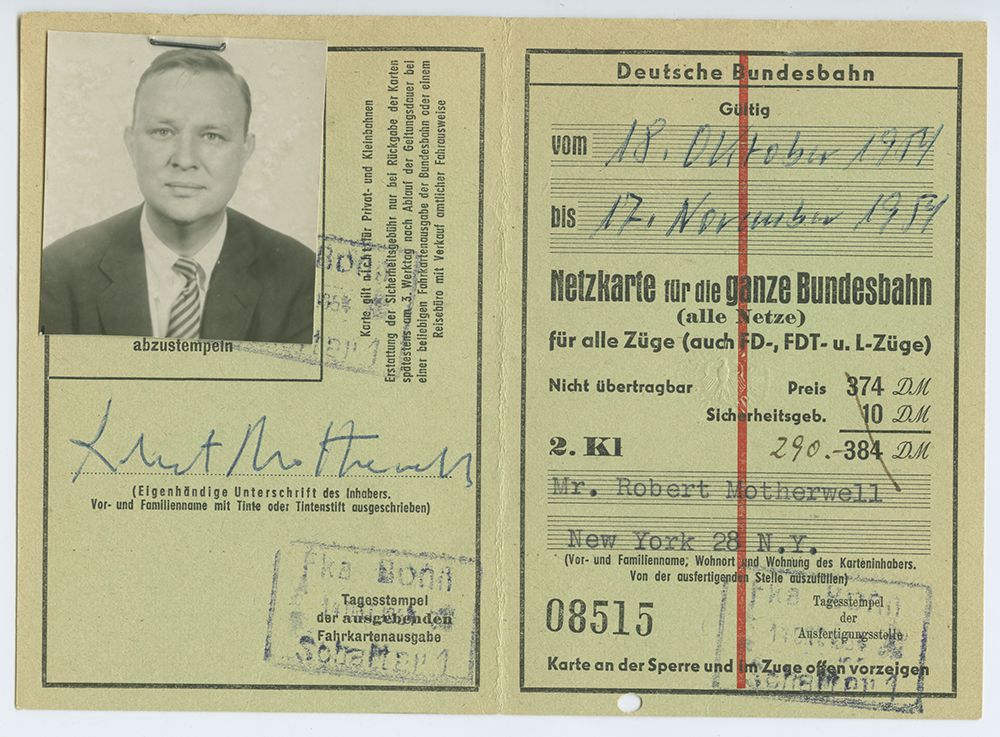
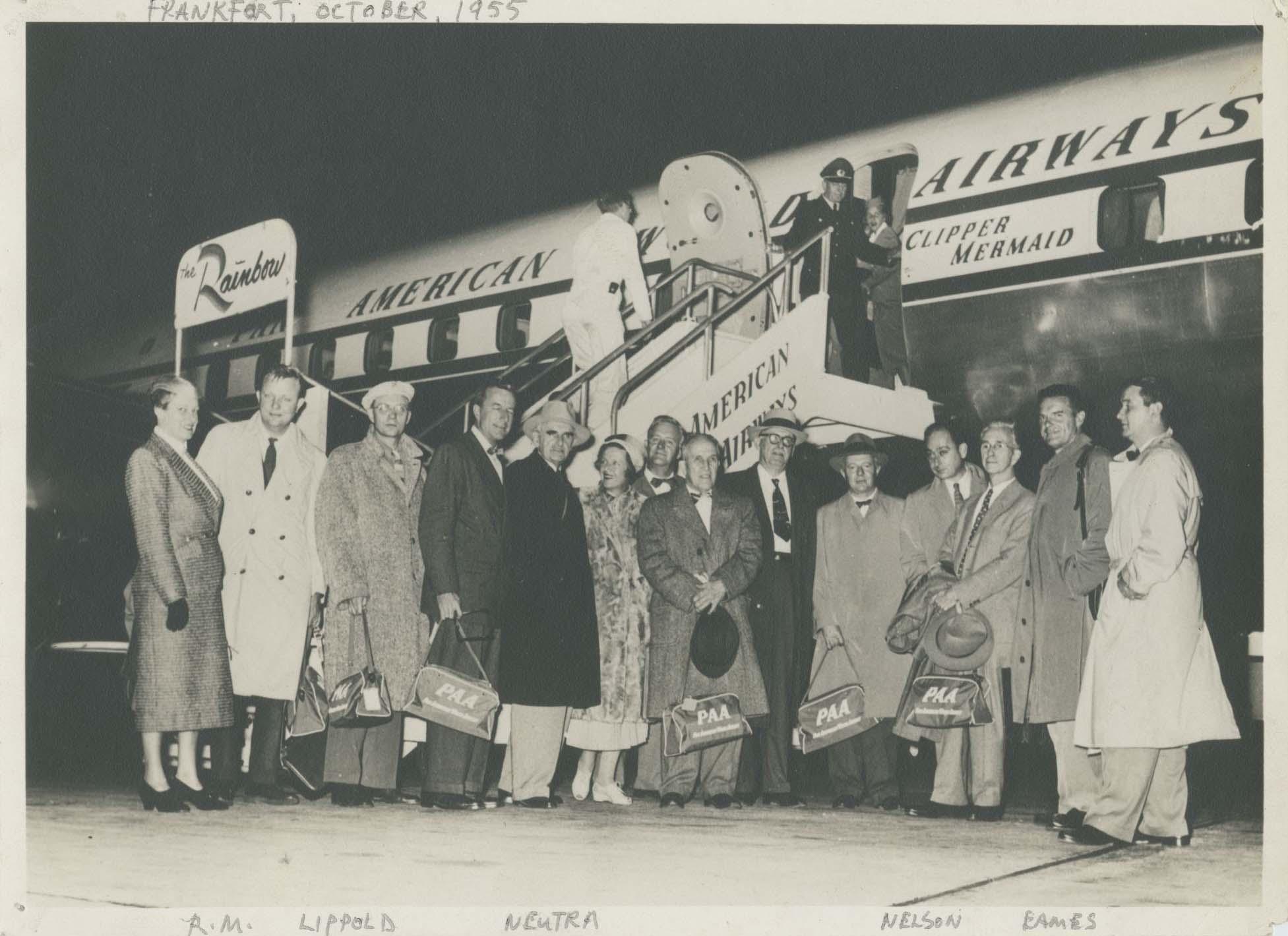
1954
In October and November, Motherwell travels throughout Germany as part of an American delegation that includes Richard Lippold, architect Richard Neutra, designers Charles Eames and George Nelson, and John Coolidge, director of the Fogg Museum. The four-week trip is sponsored by the German government as part of the planning process for the post-war reconstruction of German cities.
1955
In January, Motherwell leaves the Samuel M. Kootz Gallery after ten years.
1955
During the first half of the year, Motherwell paints a number of Je t’aime paintings. He later describes the phrase “Je t’aime” that is inscribed in large cursive script across the center of each canvas as “a cry that I would like to love.”
In the Fall, Je t’aime No. II is included in The 1955 Pittsburgh International Exhibition of Painting and Sculpture at the Carnegie Museum of Art.
1955
Motherwell’s second daughter, Lise, is born on April 14.
1956
In Februray, Shozo Shimamoto sends a letter to Motherwell to introduce the Gutai Art Group and ask him for a critique of their journal Gutai. For Motherwell, the interest of the Gutai artists represents a further affirmation of the international spirit of modernism.
In the summer, Motherwell purchases an eighteenth-century house at 622 Commercial Street in Provincetown.
1956
In October, Motherwell joins the Sidney Janis Gallery.
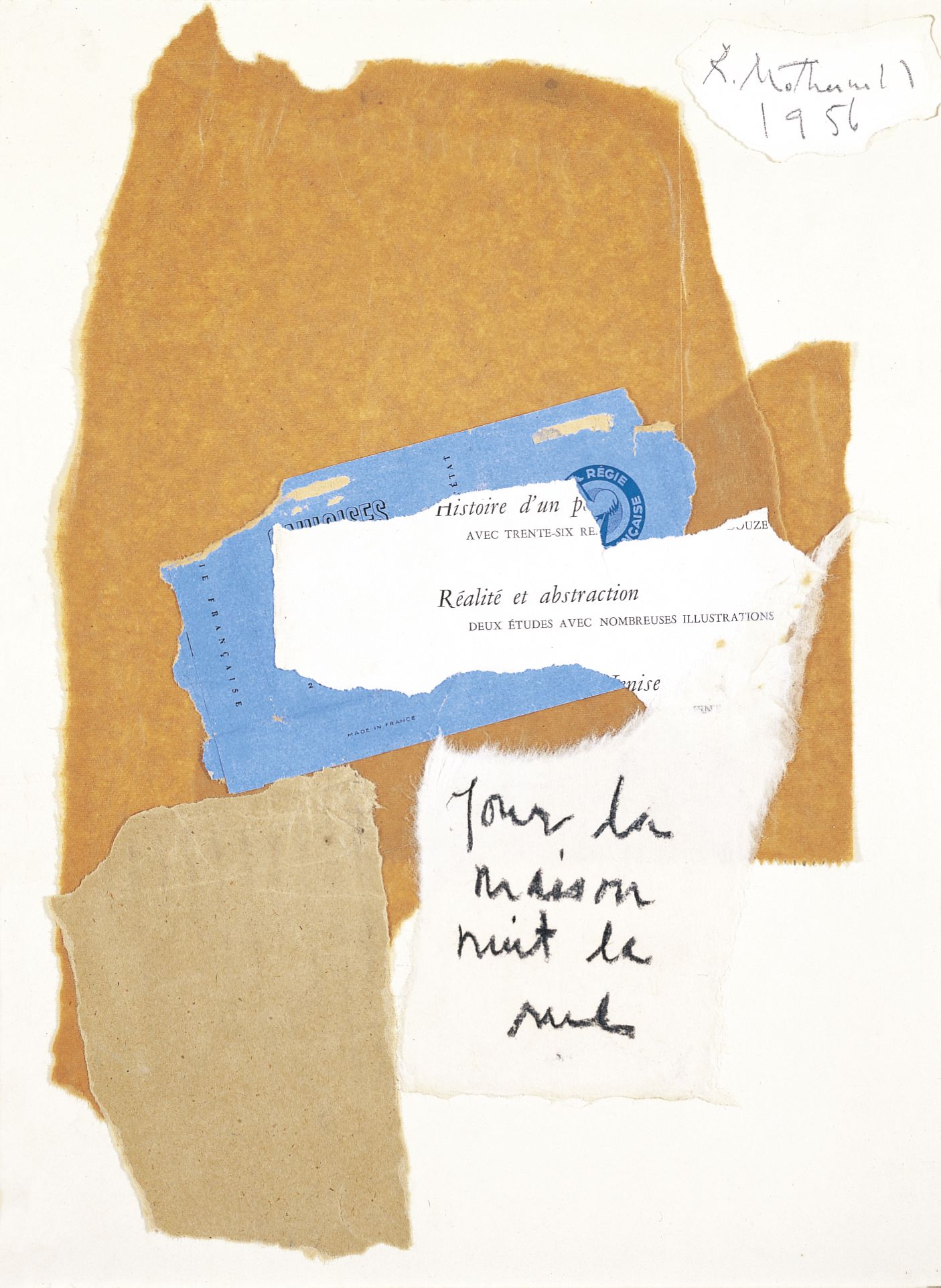
Histoire d’un Peintre, 1956
1956
Motherwell creates a series of new collages, several of which include fragments of poems by Paul Eluard, including “Jour la maison nuit la rue,” which comes from Eluard’s poem “Par un baiser.”

Elegy to the Spanish Republic XXXIV, 1953—54
1957
In April, Elegy to the Spanish Republic XXXIV is exhibited in 8 Americans at the Sidney Janis Gallery. Seymour H. Knox buys the painting and donates it to the Albright Art Gallery in Buffalo, N.Y.
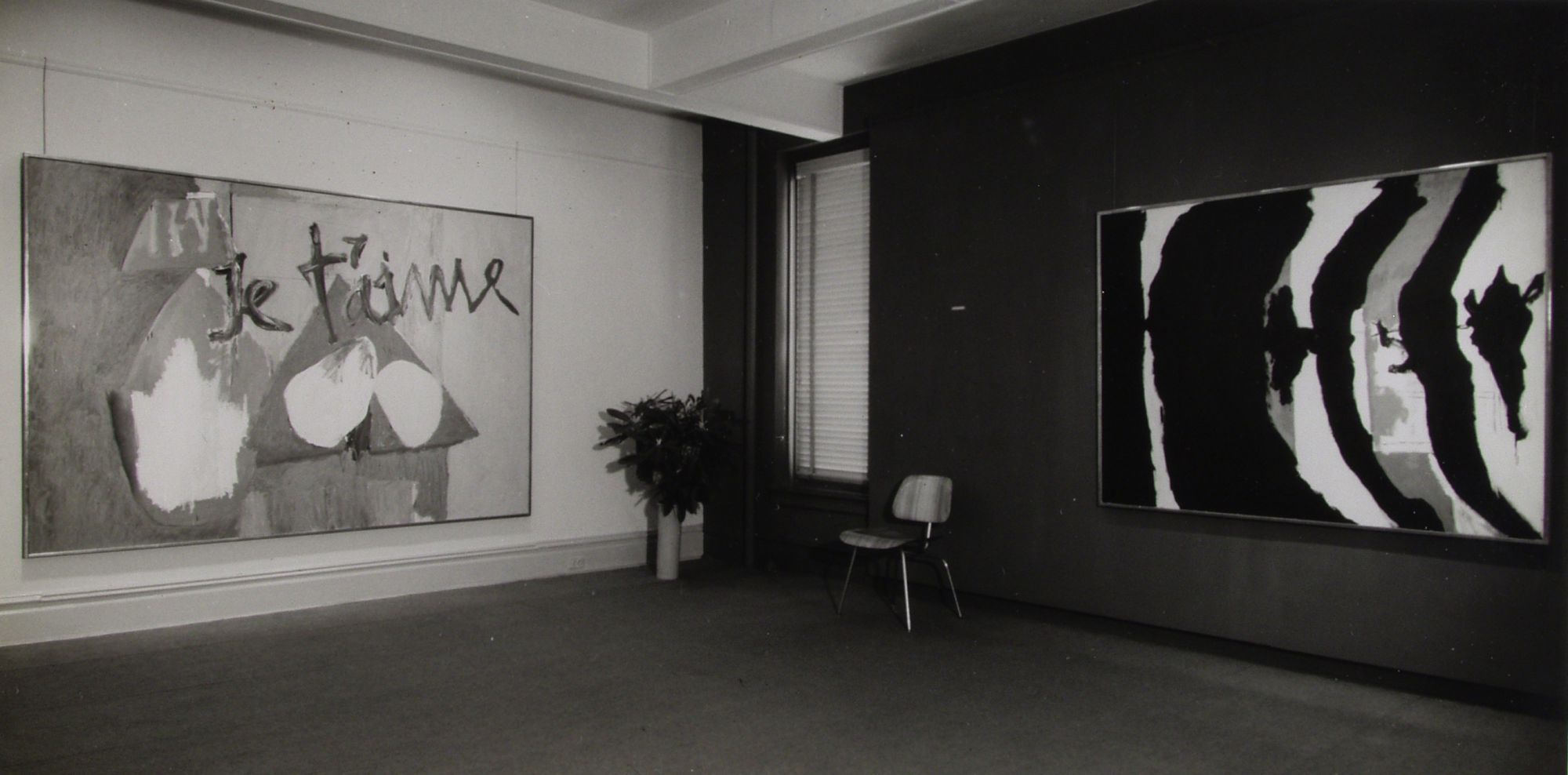
Installation view of Robert Motherwell at the Sidney Janis Gallery, New York, May 1957. From left to right: Je t’aime IV and Wall Painting No. III
1957
In May, Motherwell’s first solo exhibition opens at the Sidney Janis Gallery. It features eighteen works from the past four years and includes both paintings and collages. He will continue to show at the gallery until 1962.
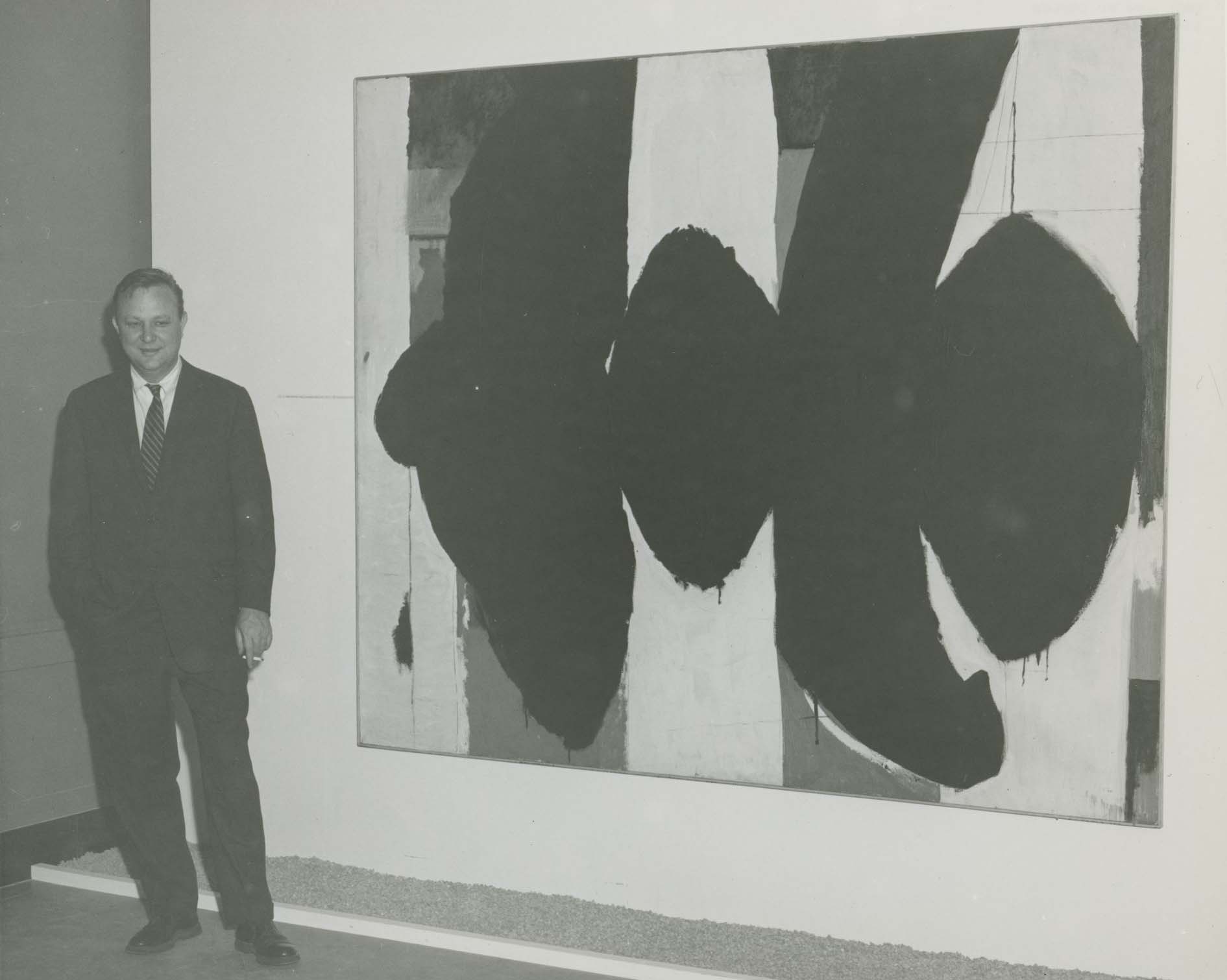
Motherwell with Elegy to the Spanish Republic XXXIV at the opening of Contemporary Art: Recent Acquisitions, 1954–57
1957
In May, Elegy to the Spanish Republic XXXIV is included in Contemporary Art: Recent Acquisitions, 1954-57 at the Albright Art Gallery in Buffalo.
1957
Motherwell and Betty return to Provincetown for the summer. Realizing that their marital difficulties are unsurmountable, they decide to end their marriage.
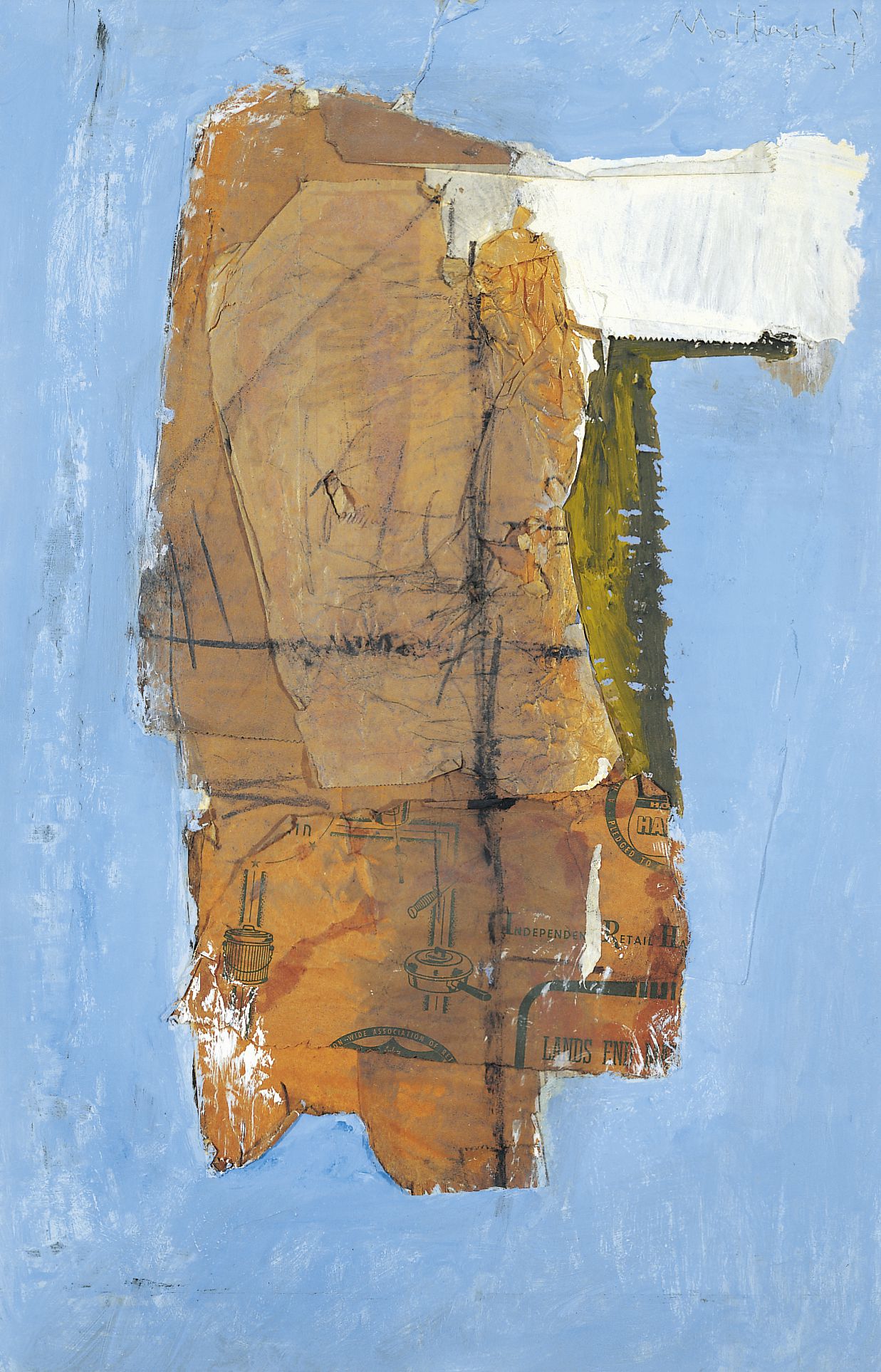
Helen’s Collage, 1957
1957
Toward the end of the year, Motherwell begins a relationship with the painter Helen Frankenthaler.
He later retitles a collage made in the fall of 1957 as Helen’s Collage.

